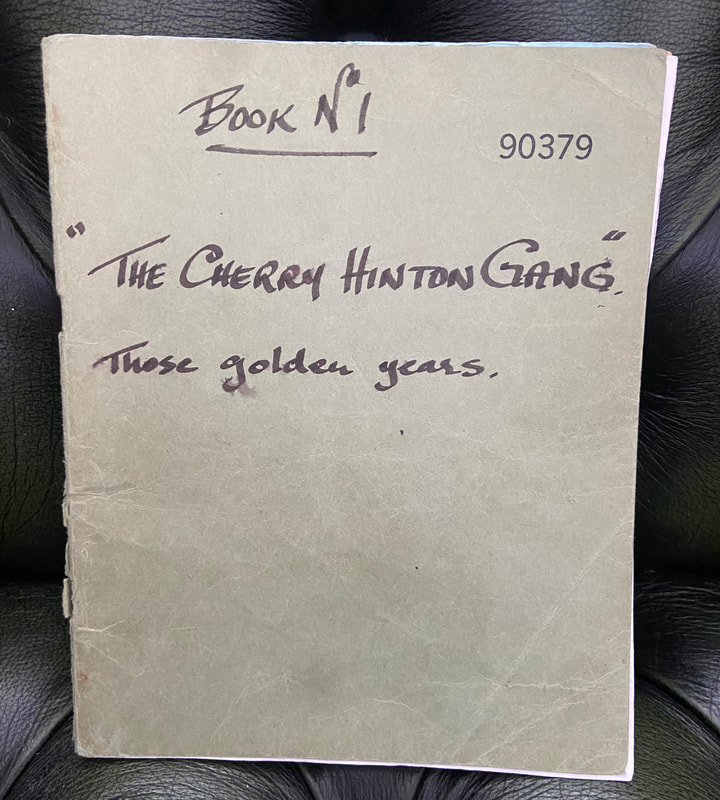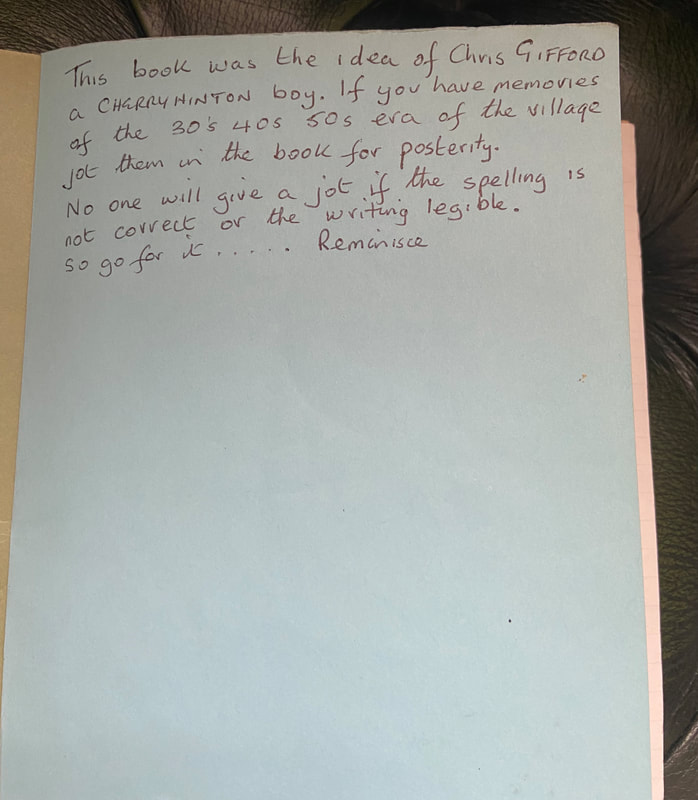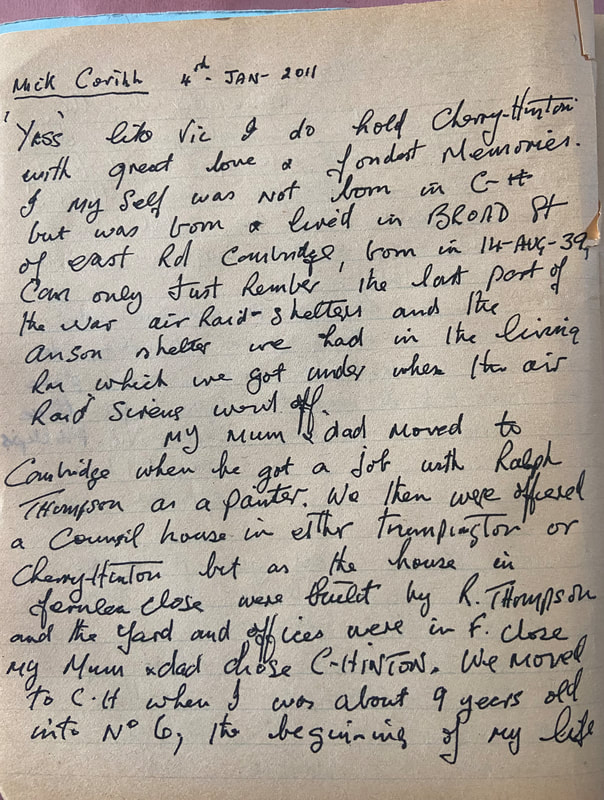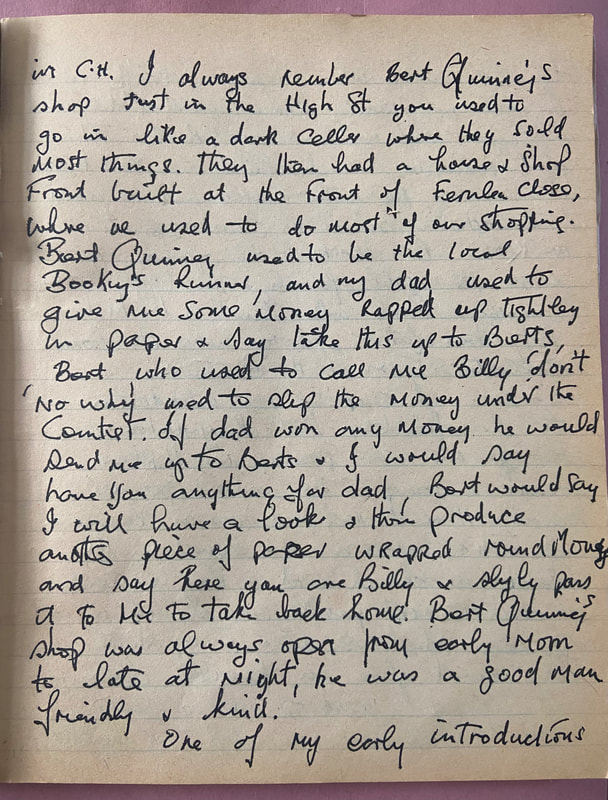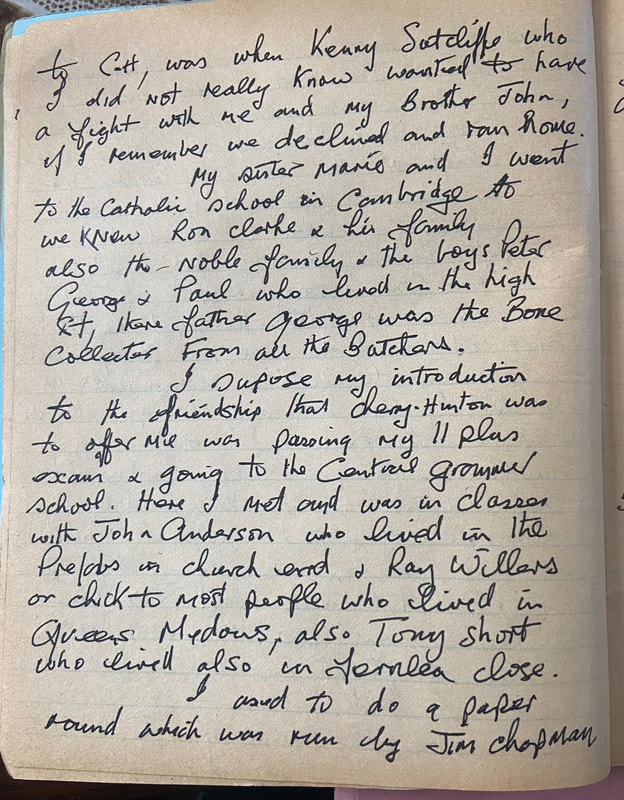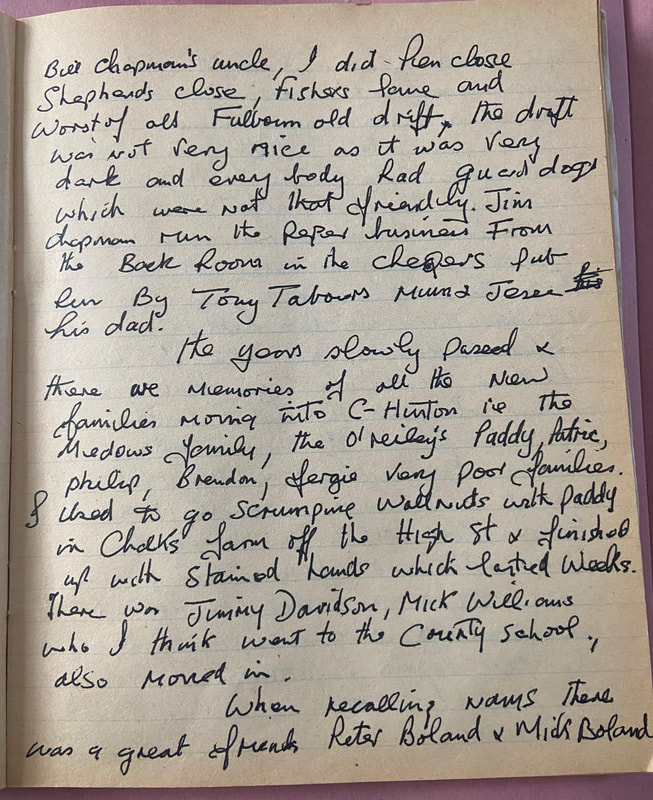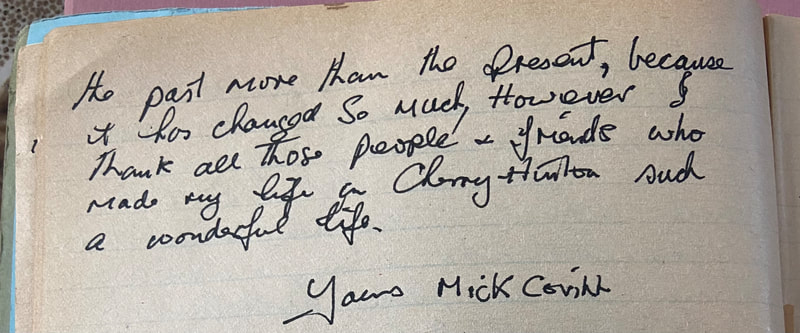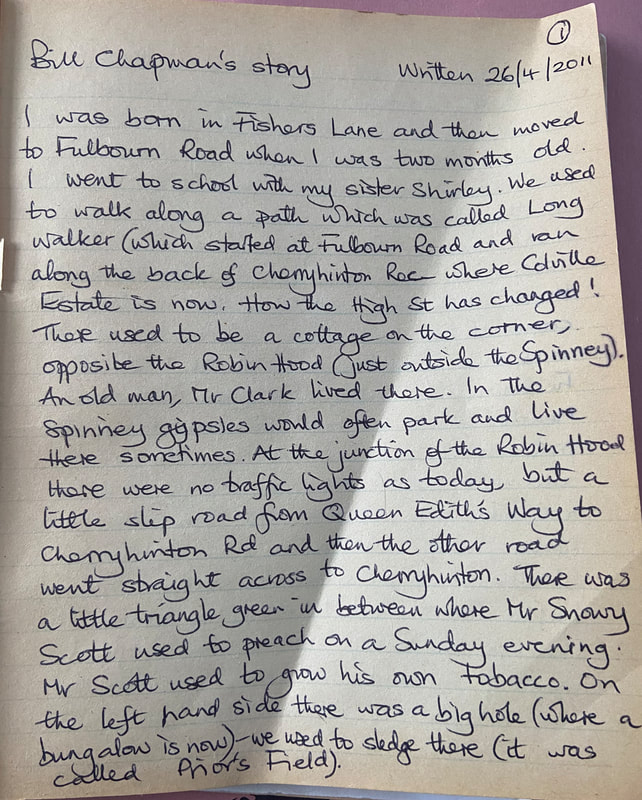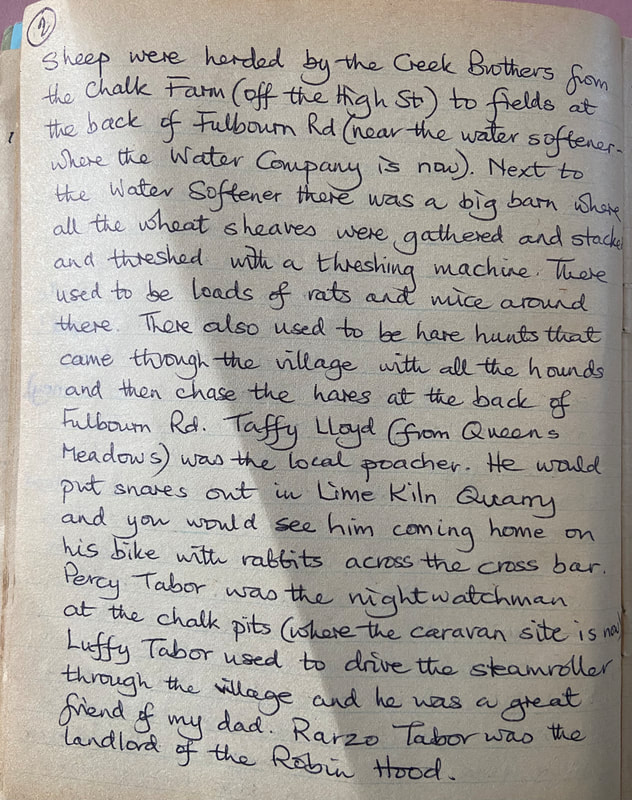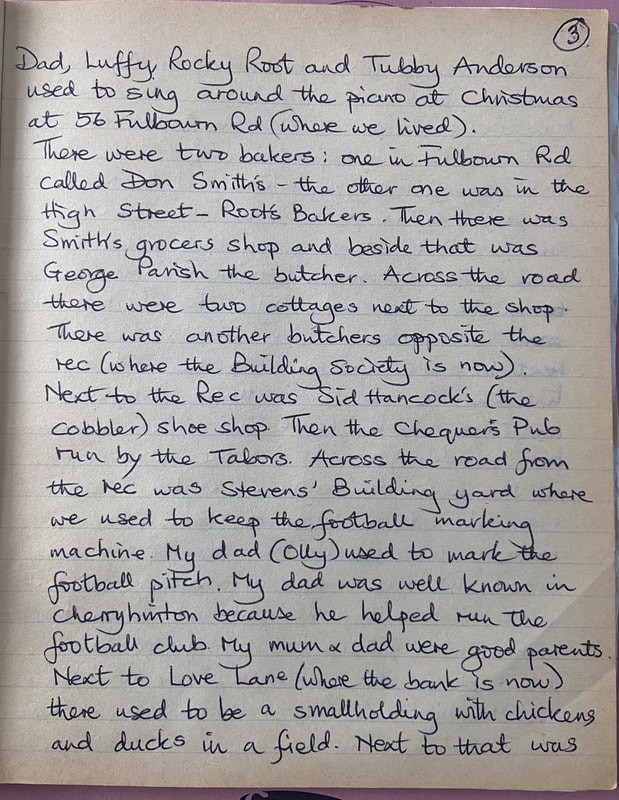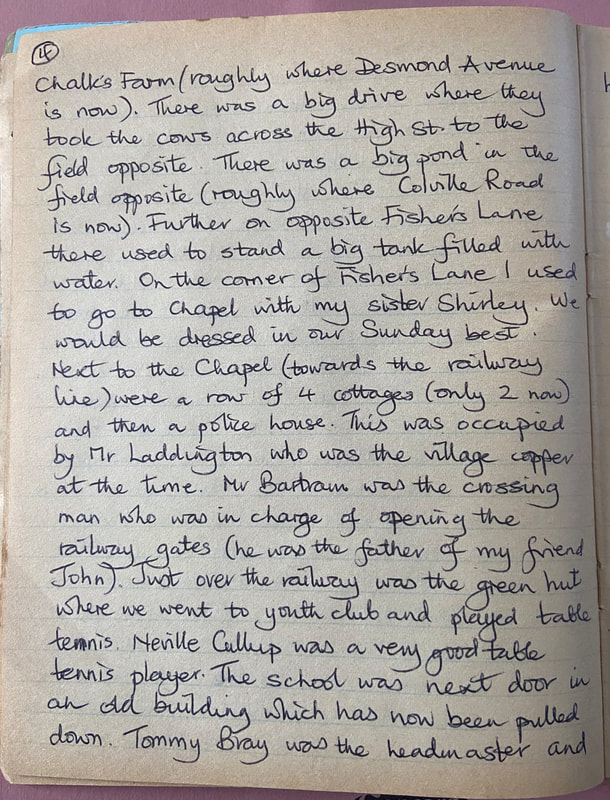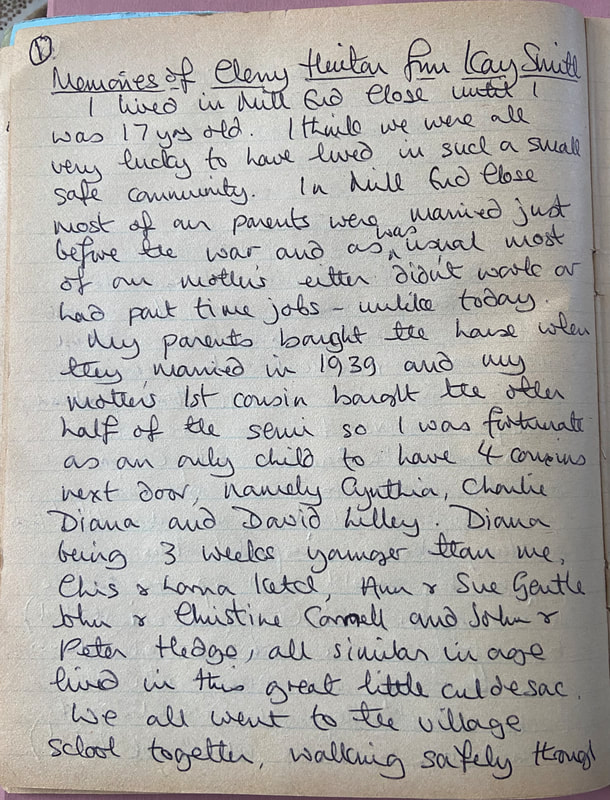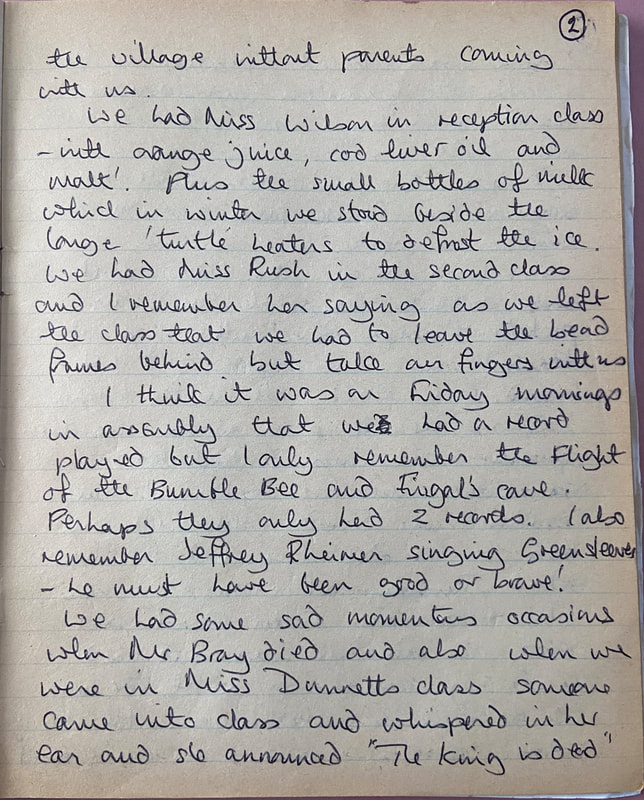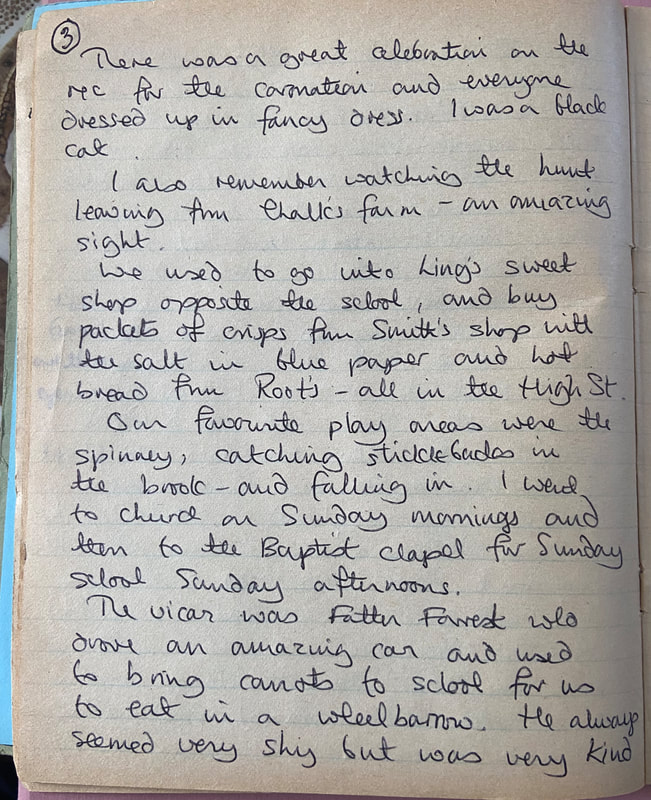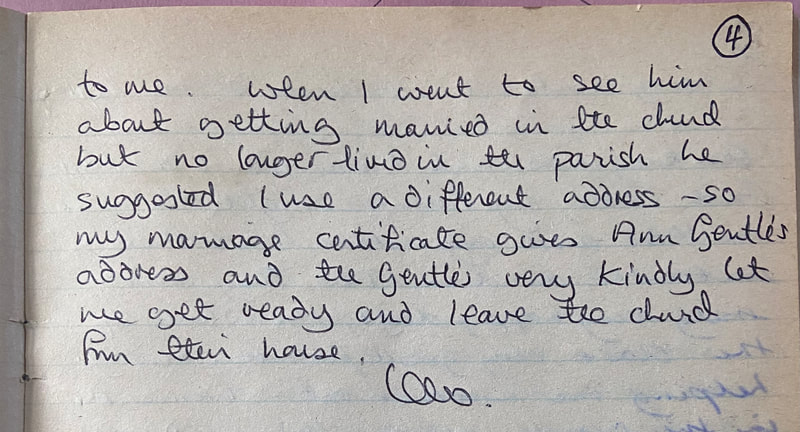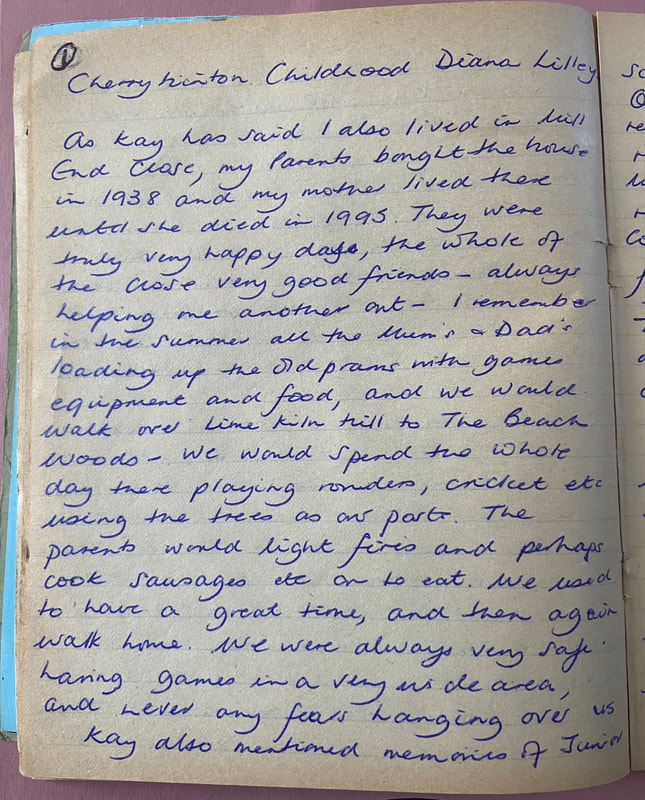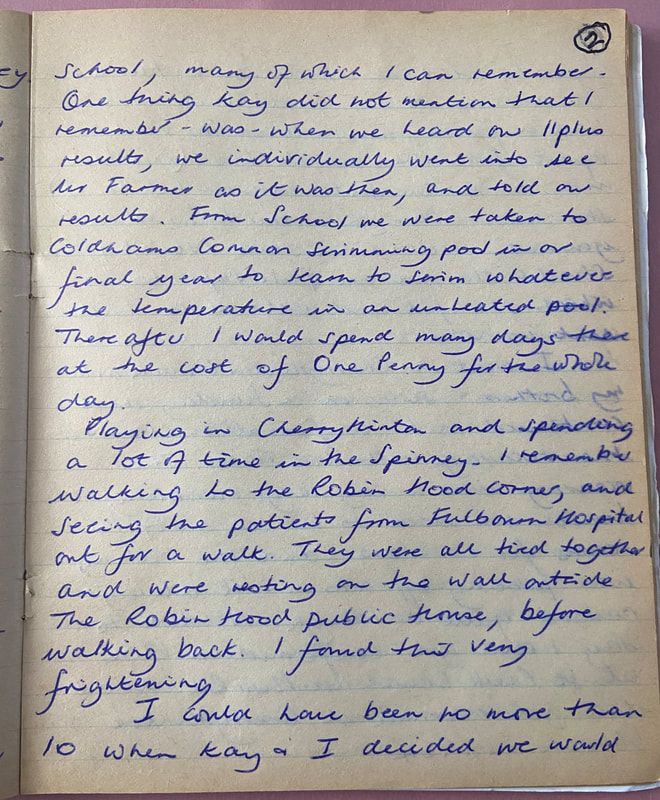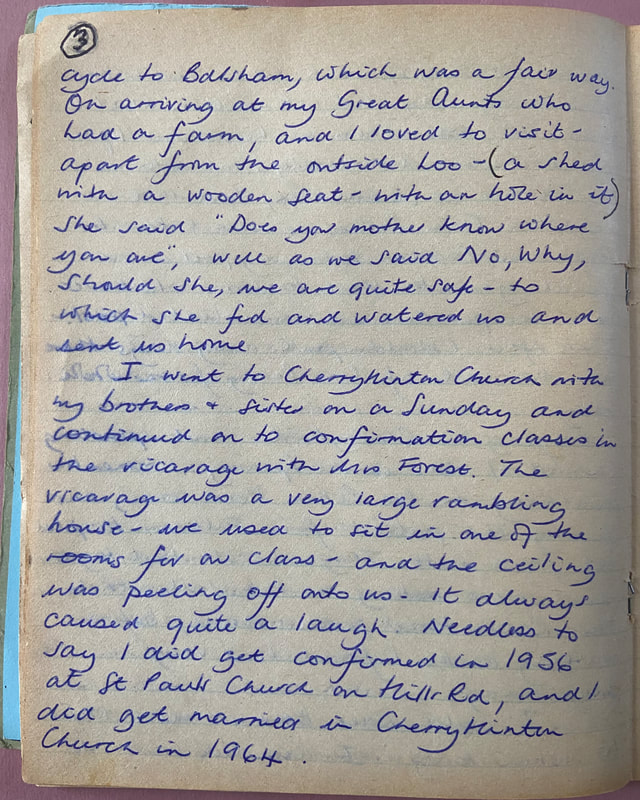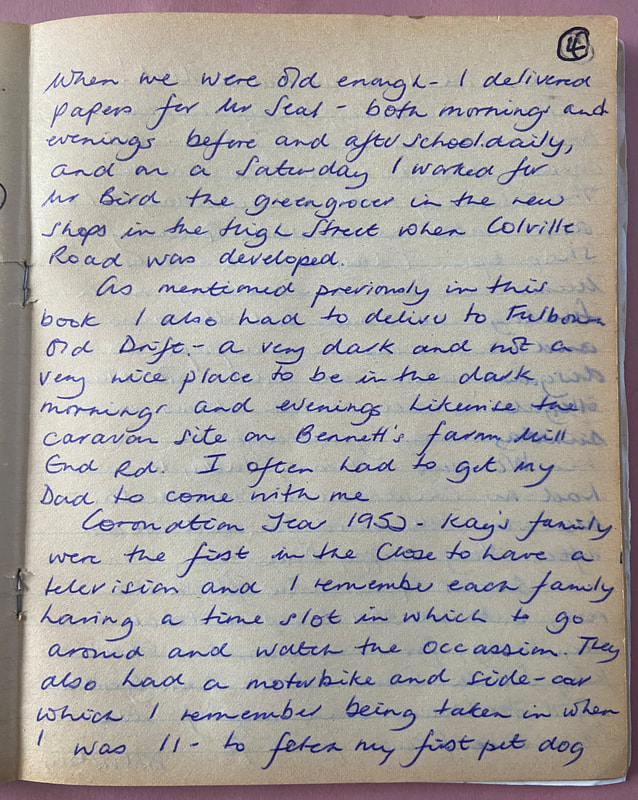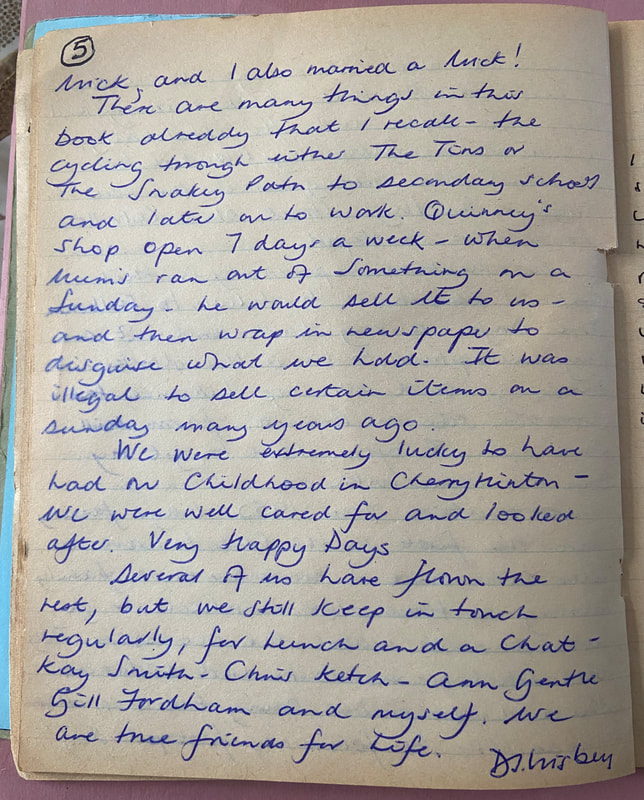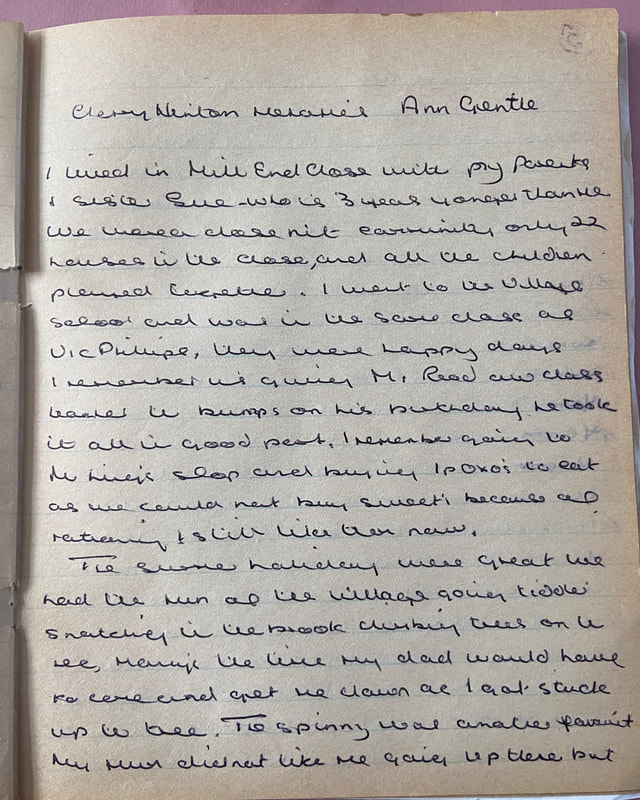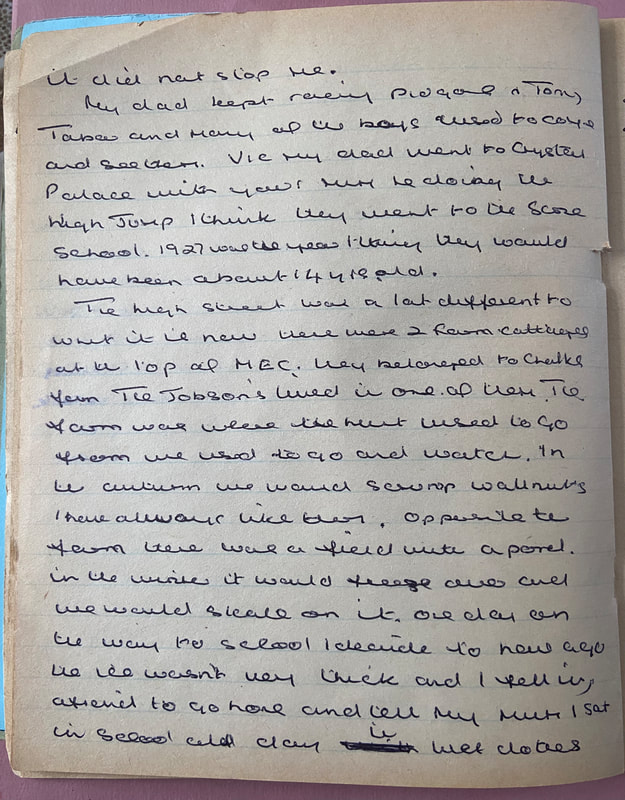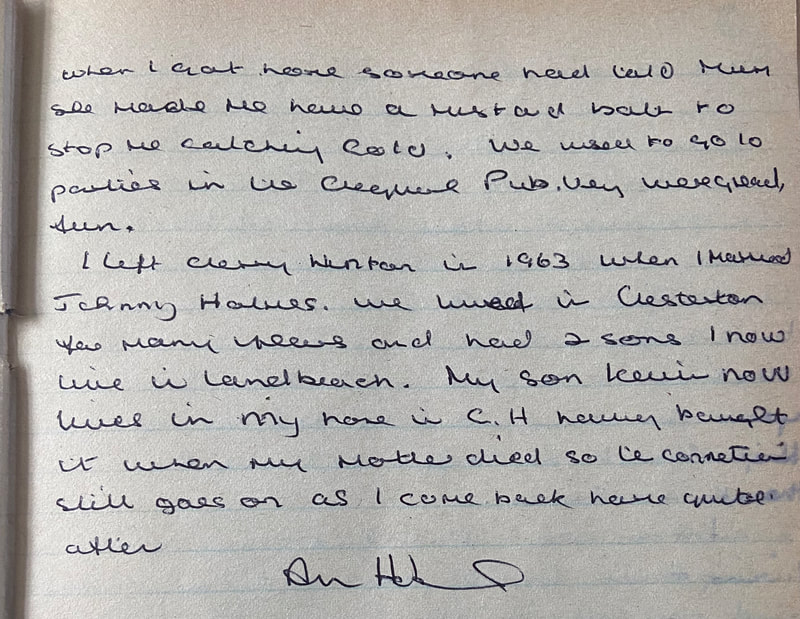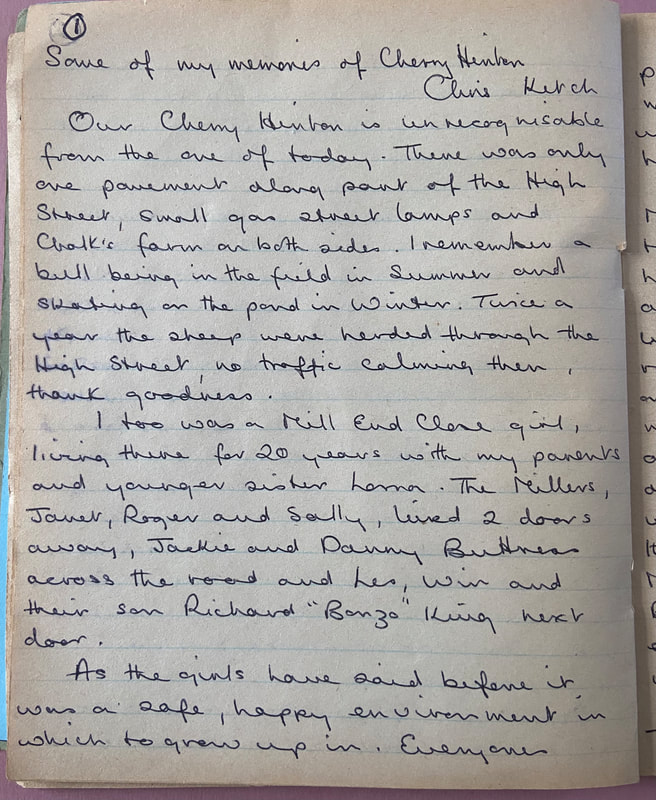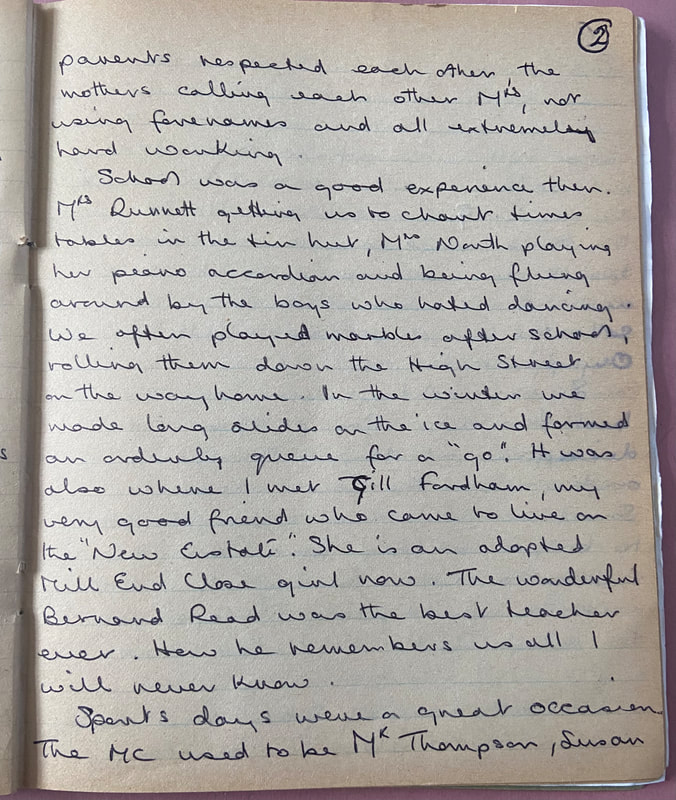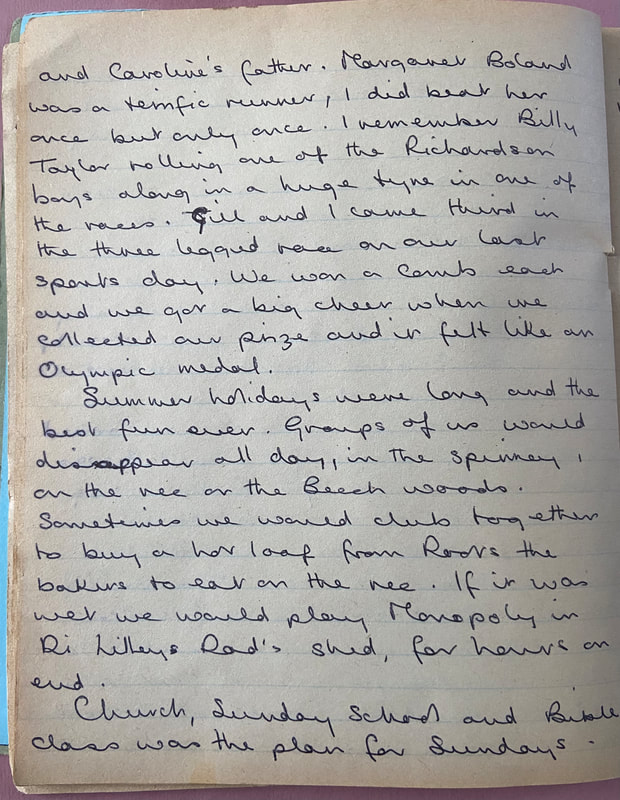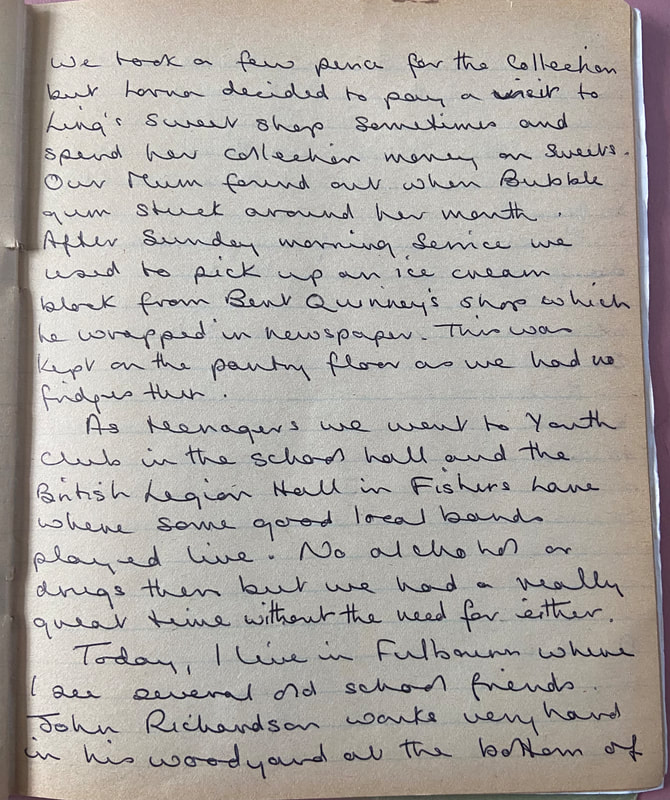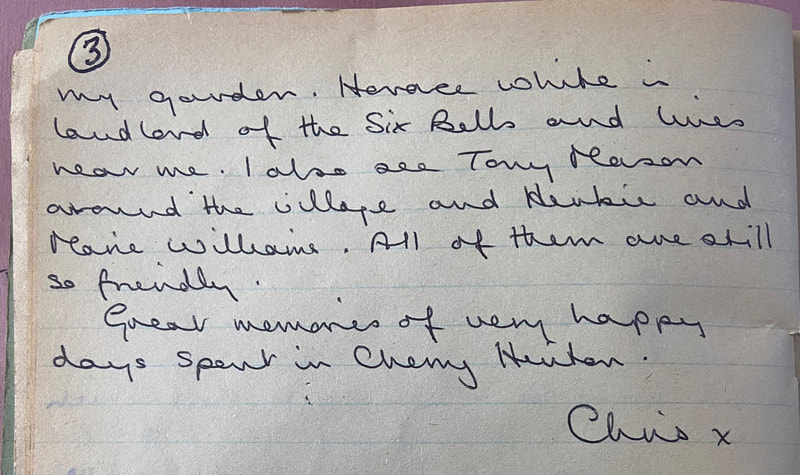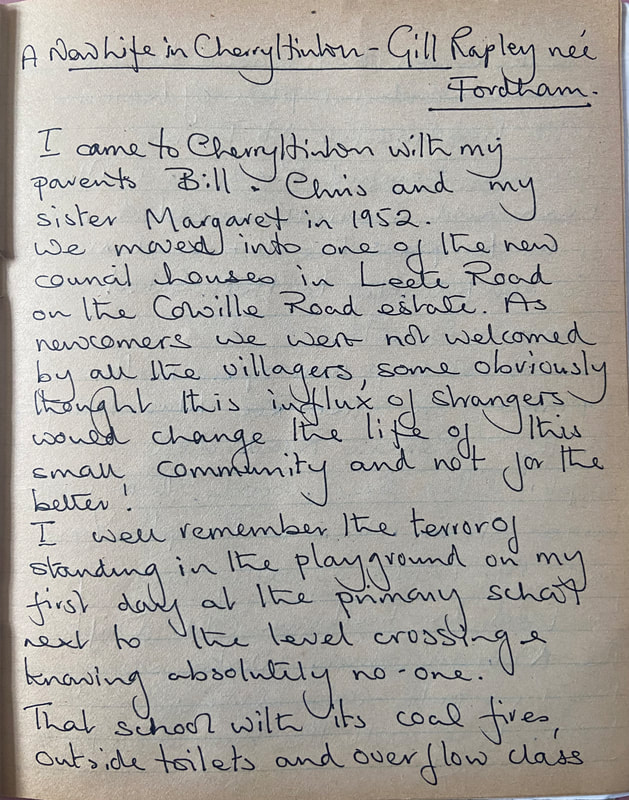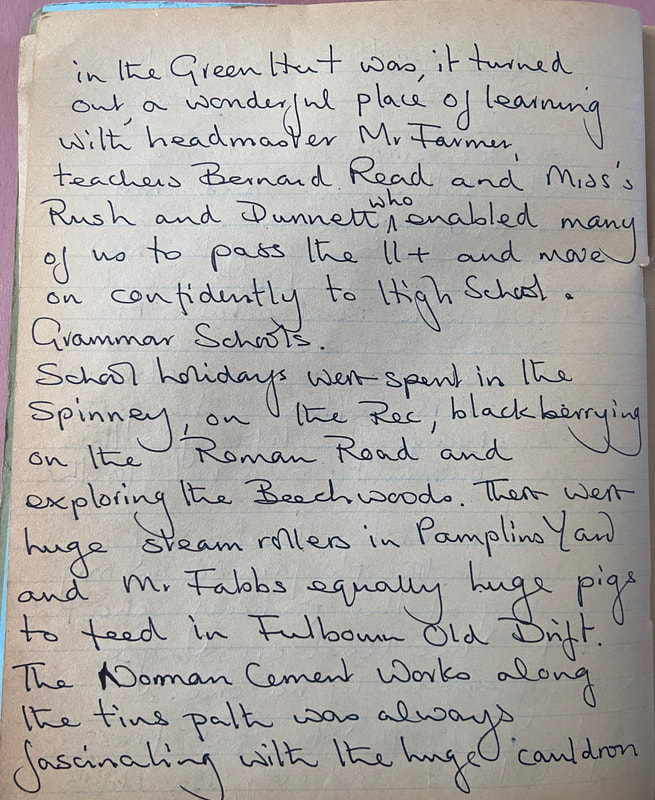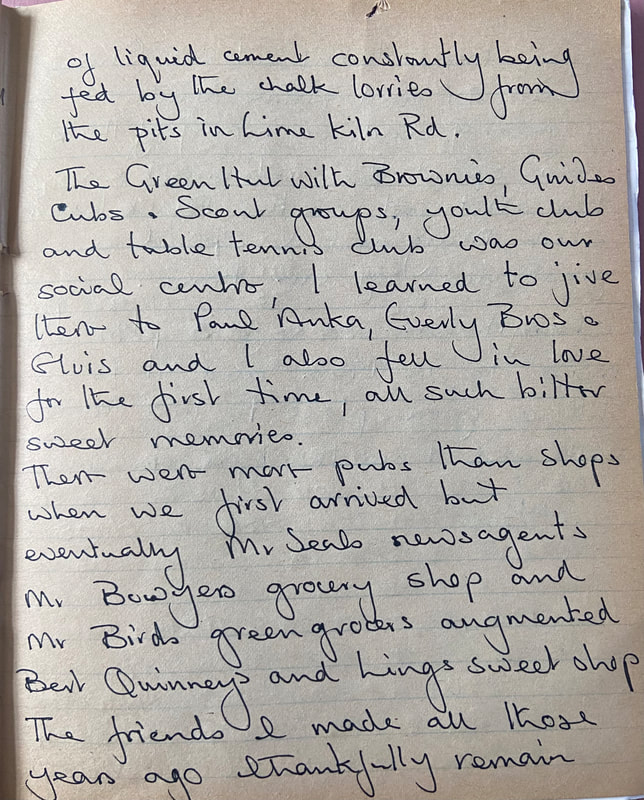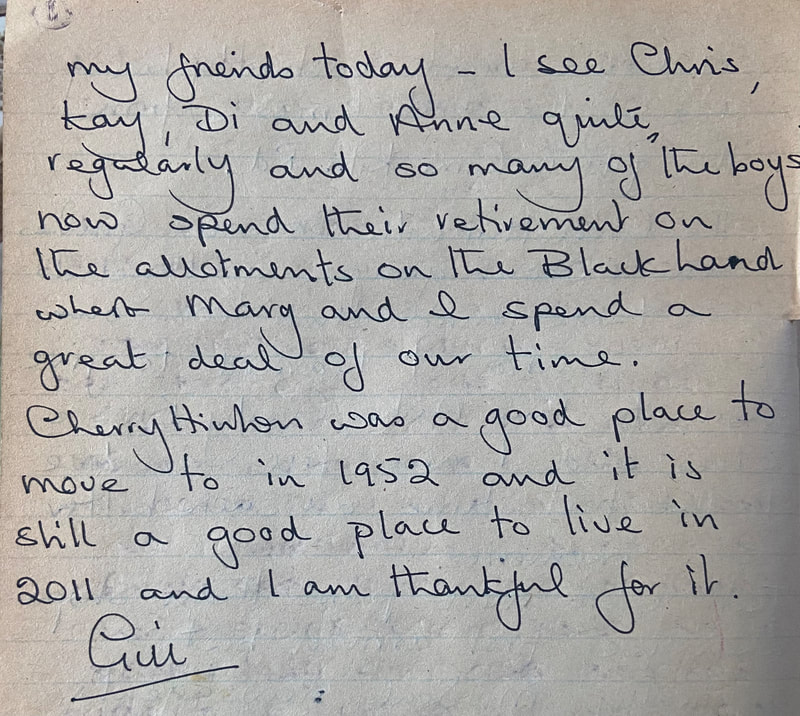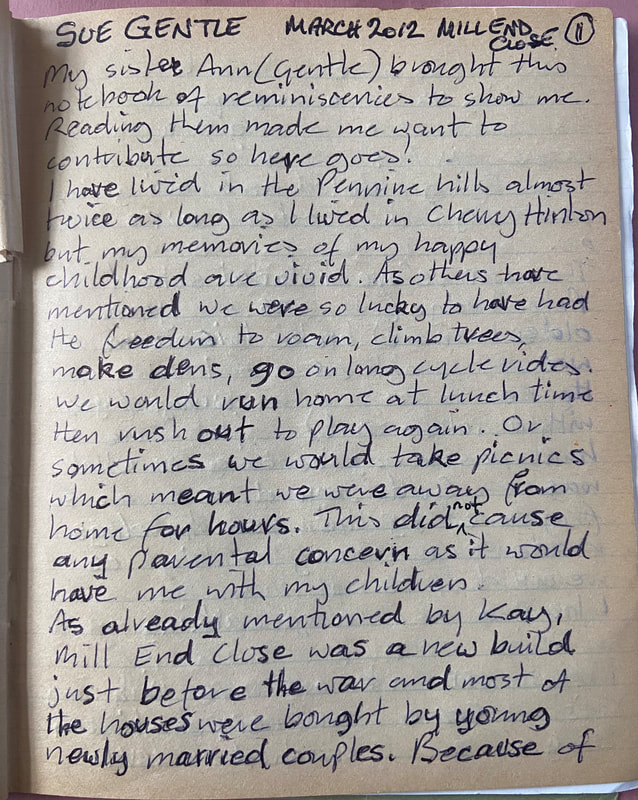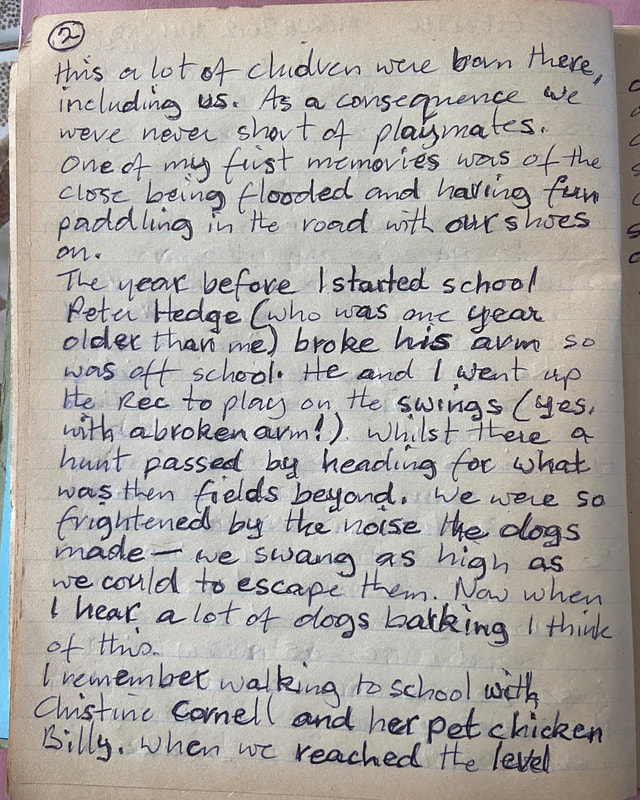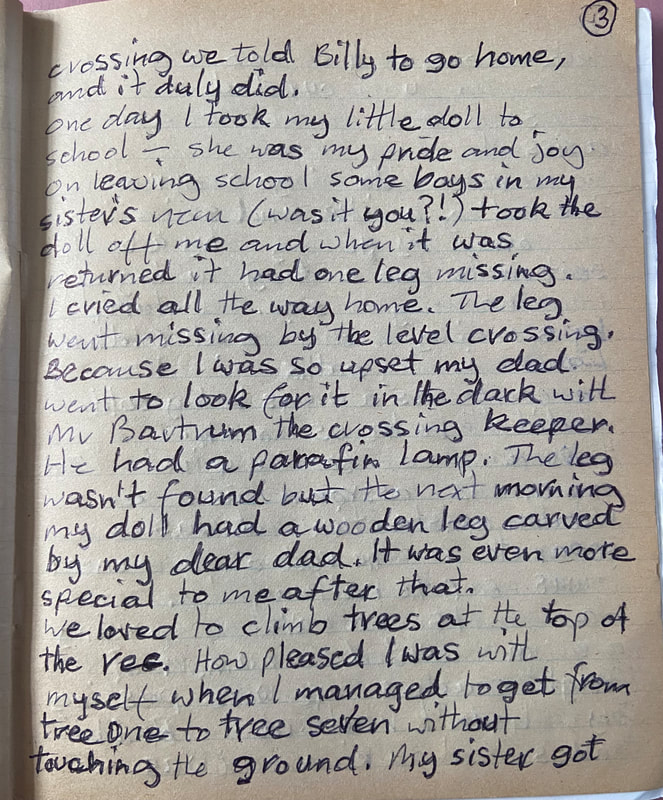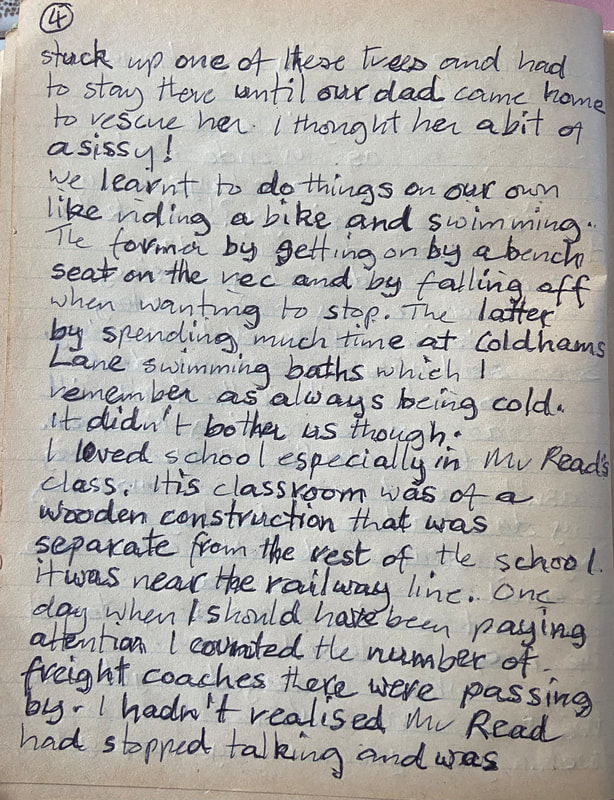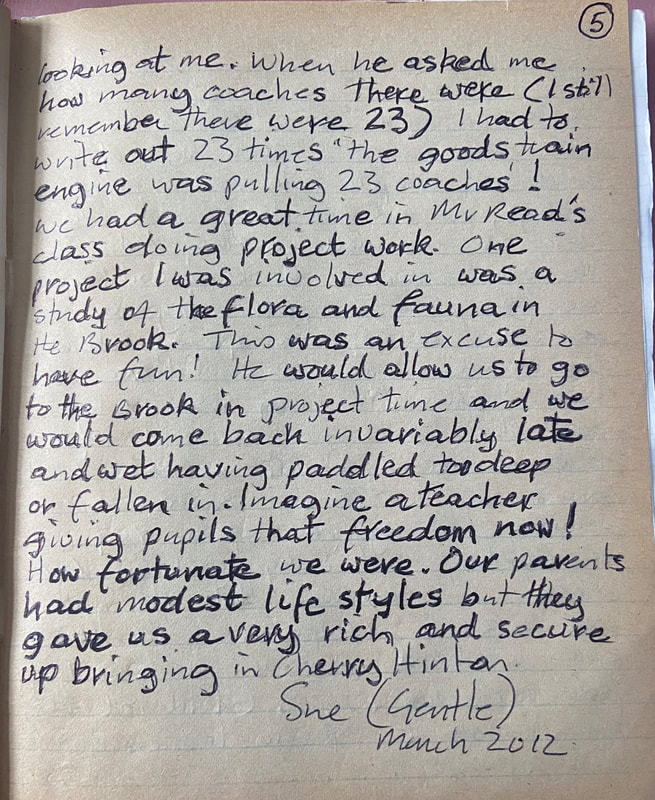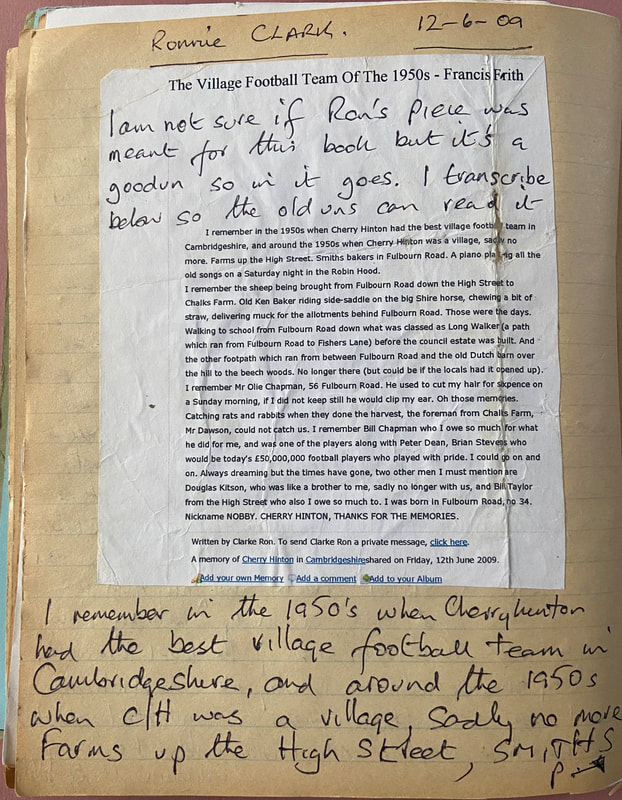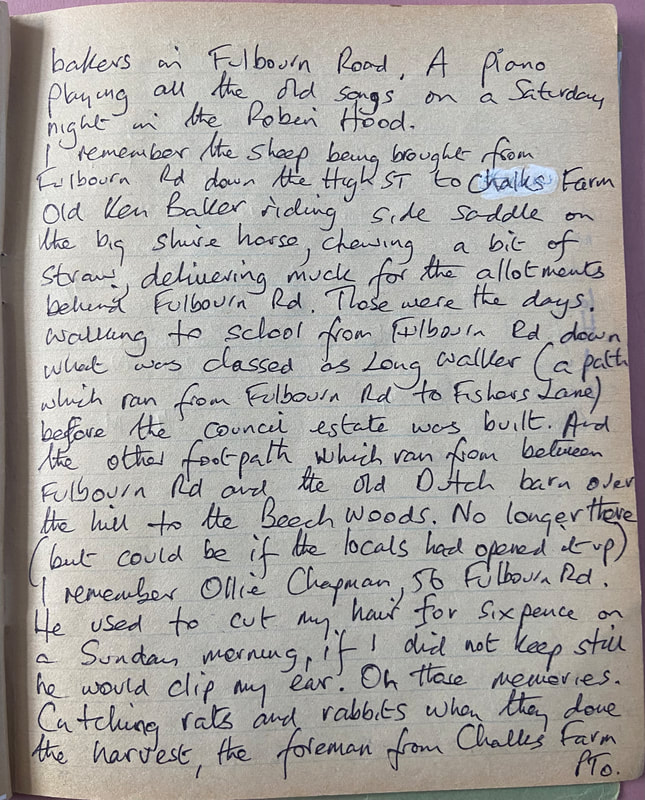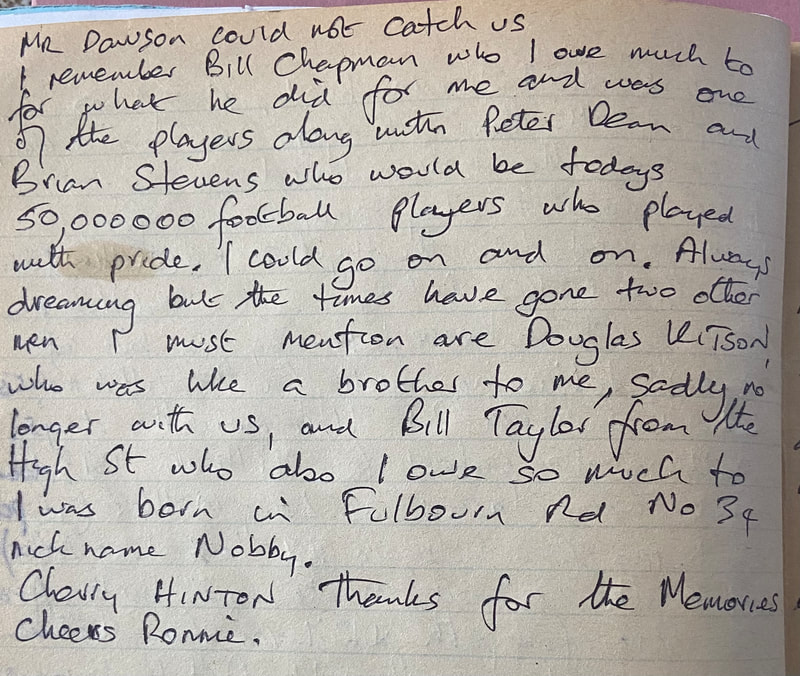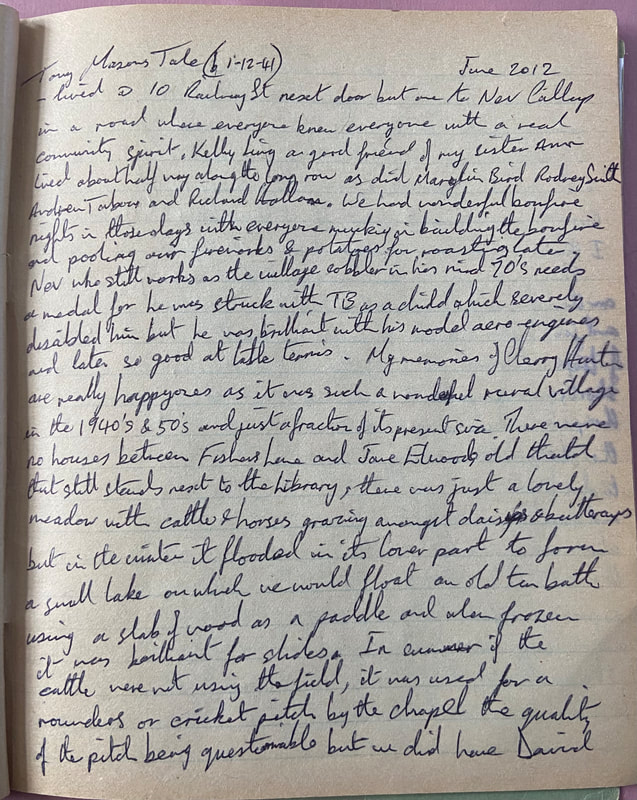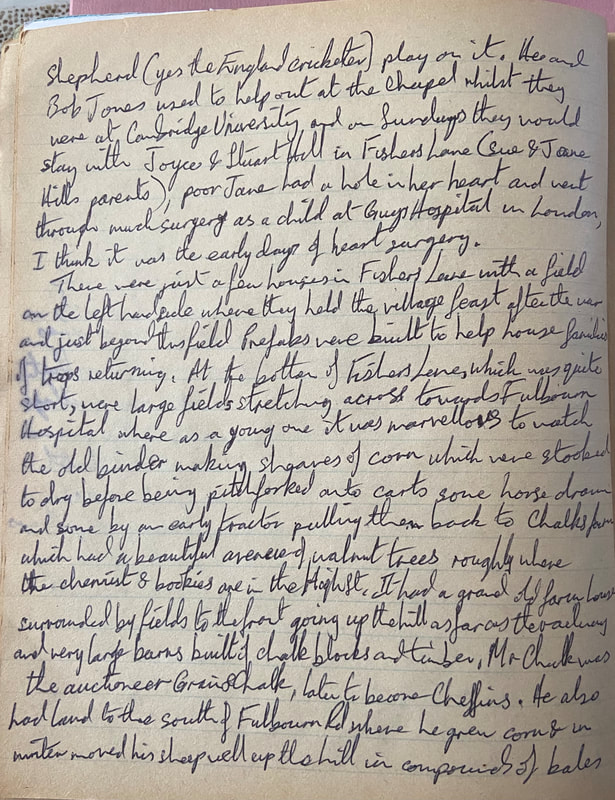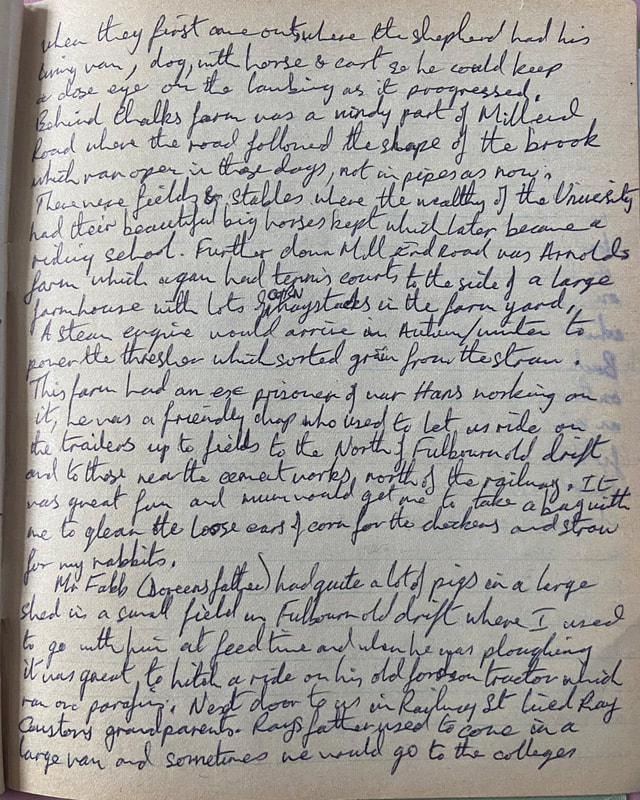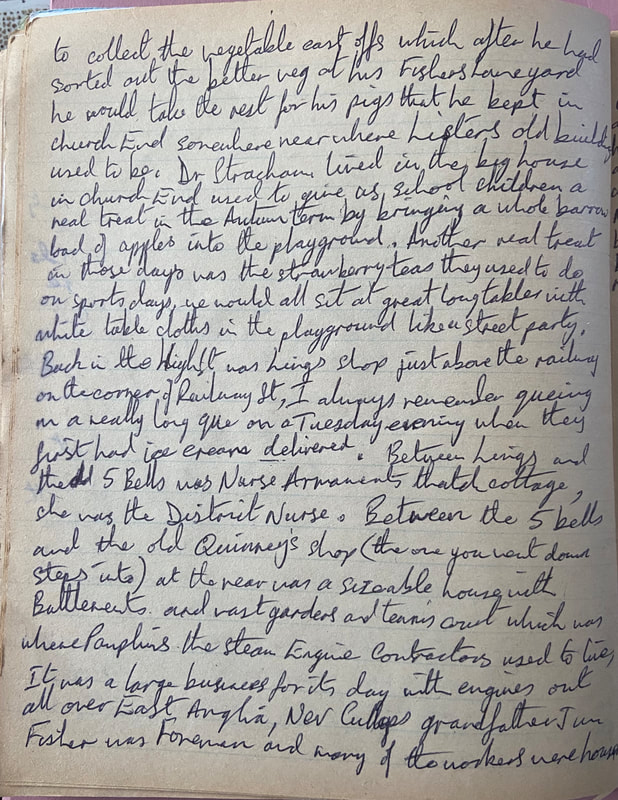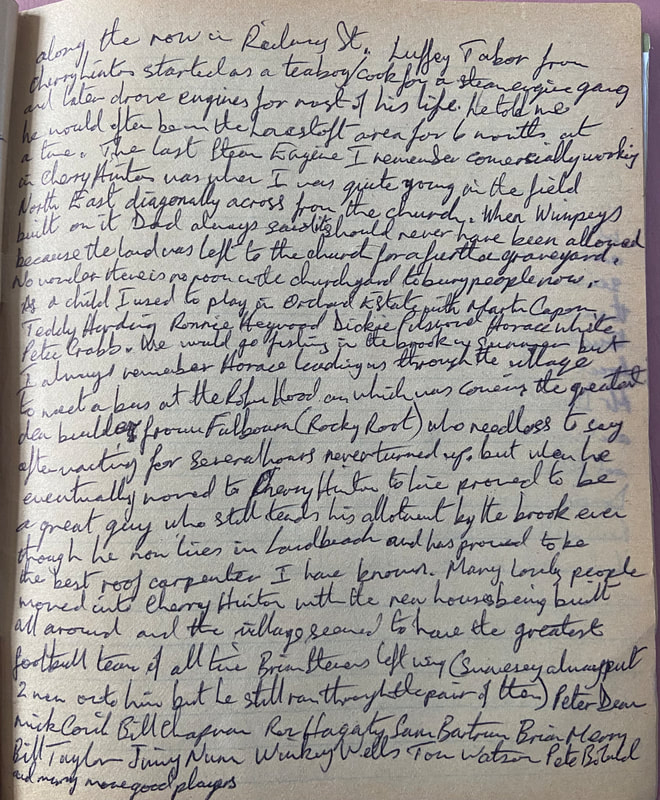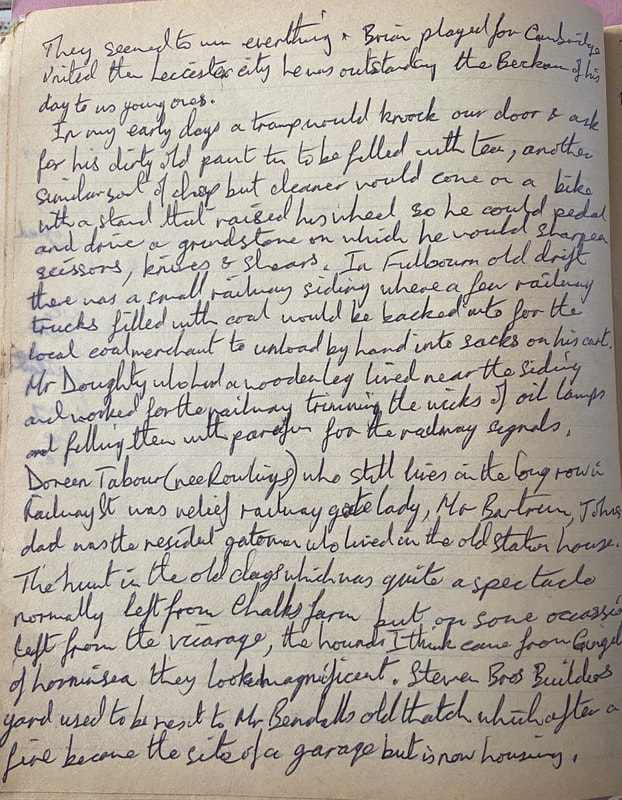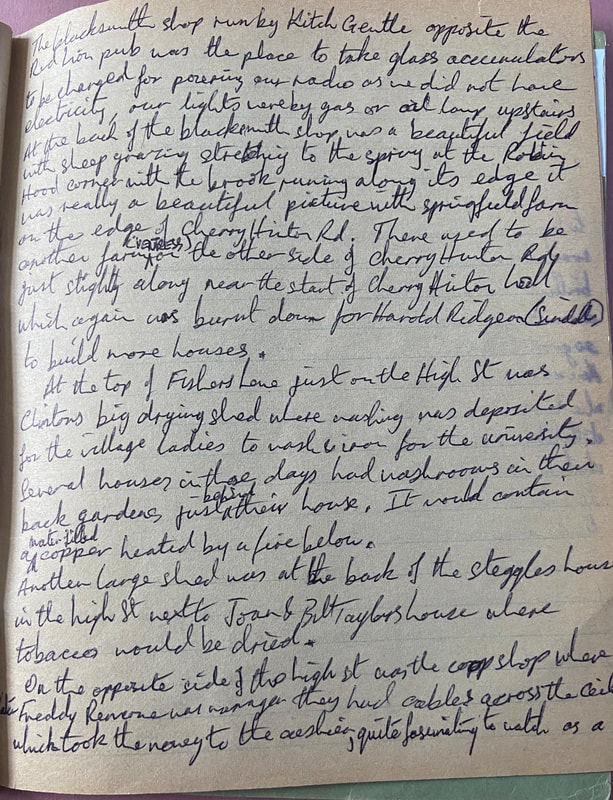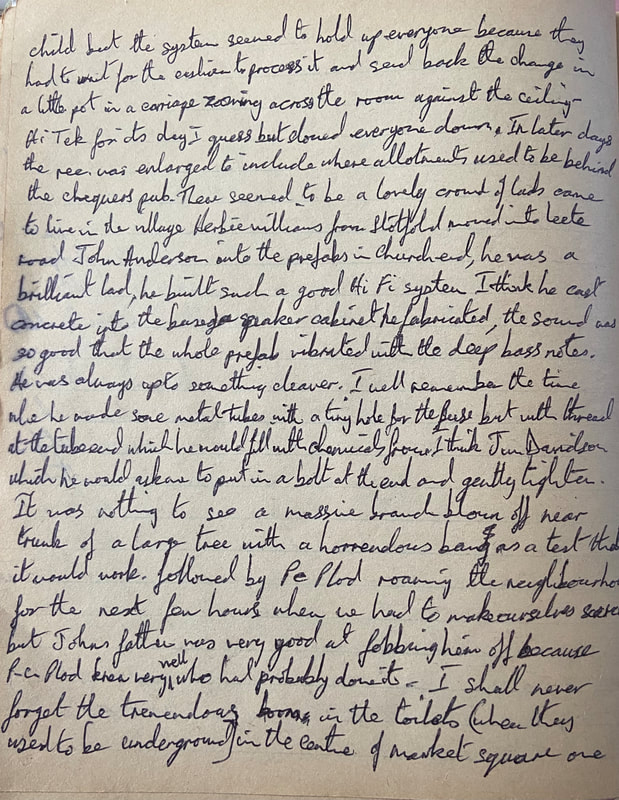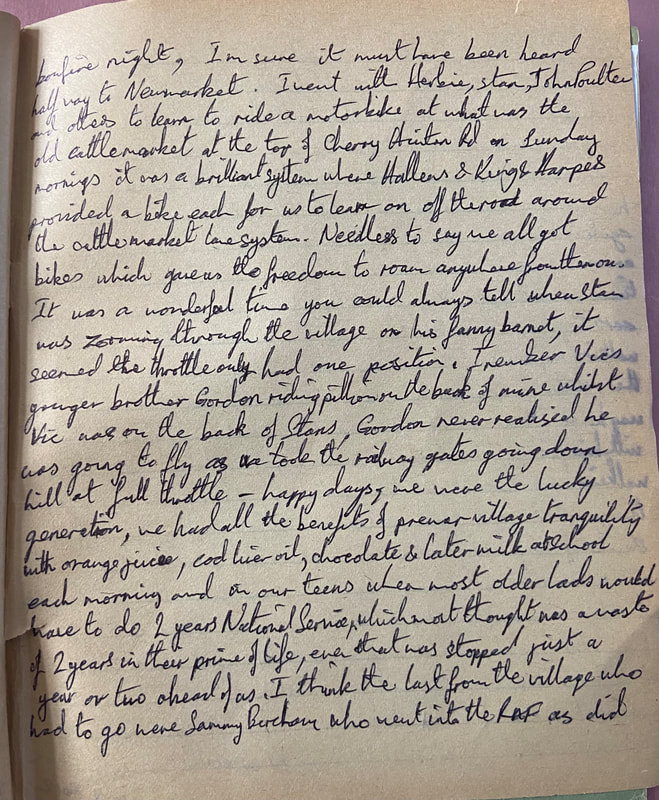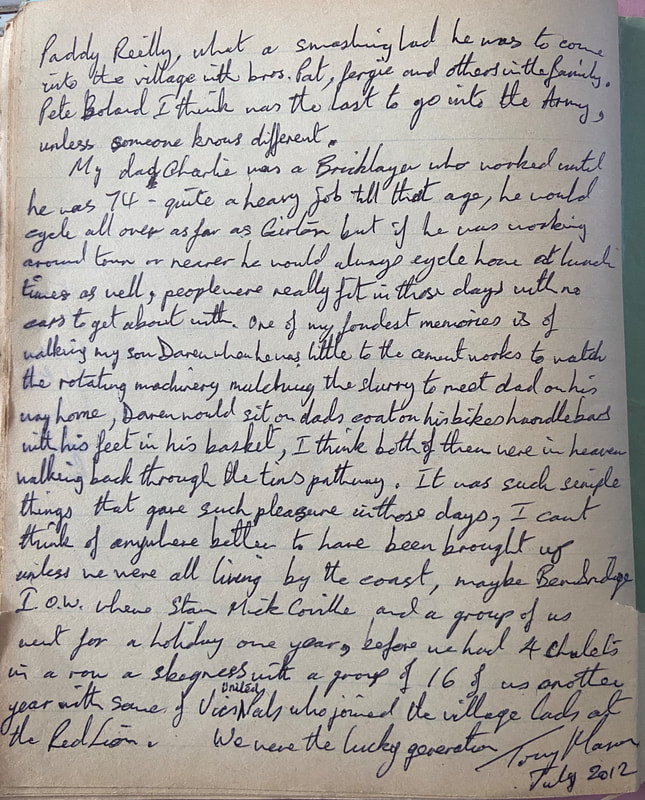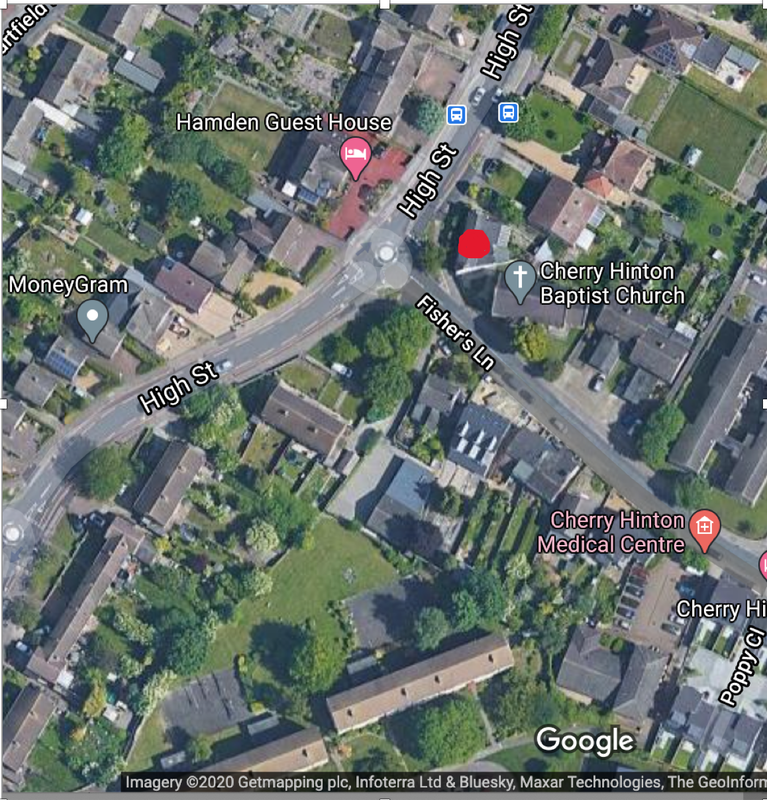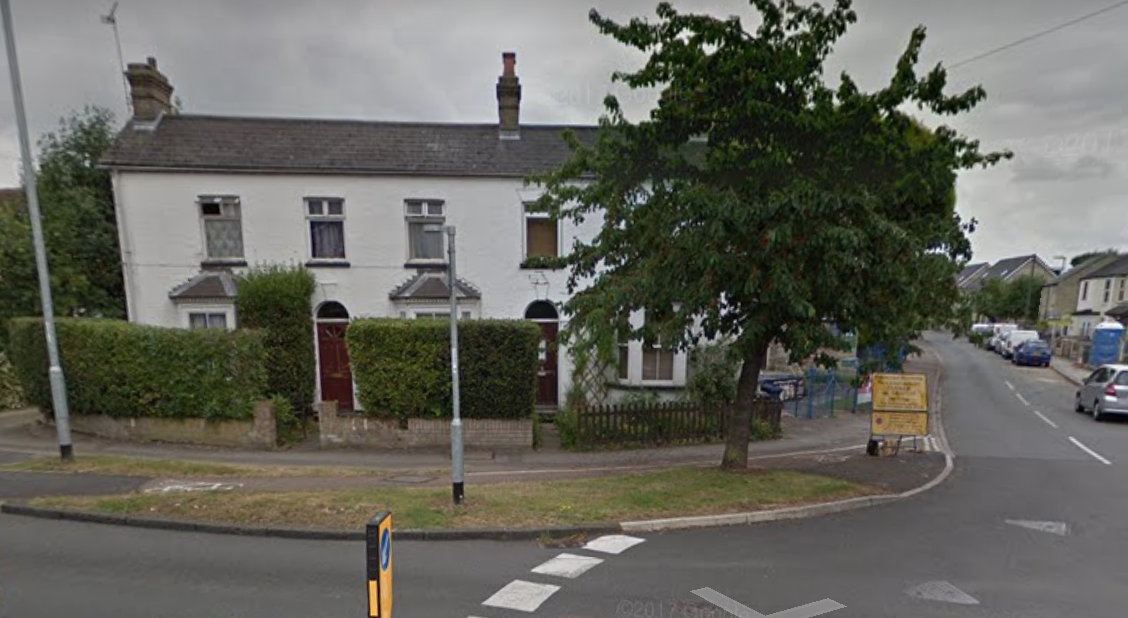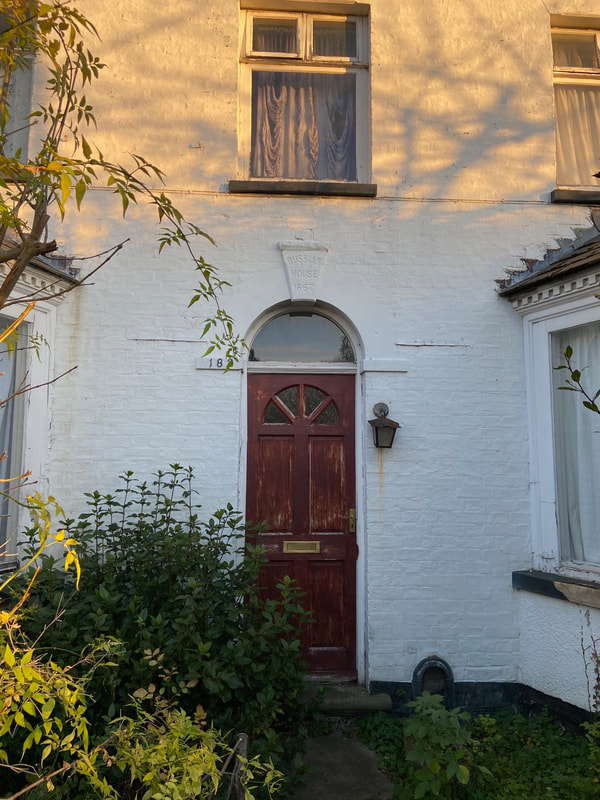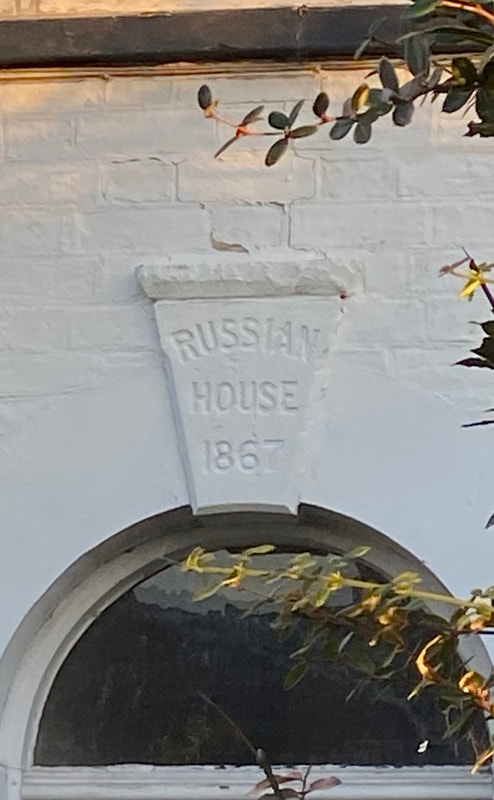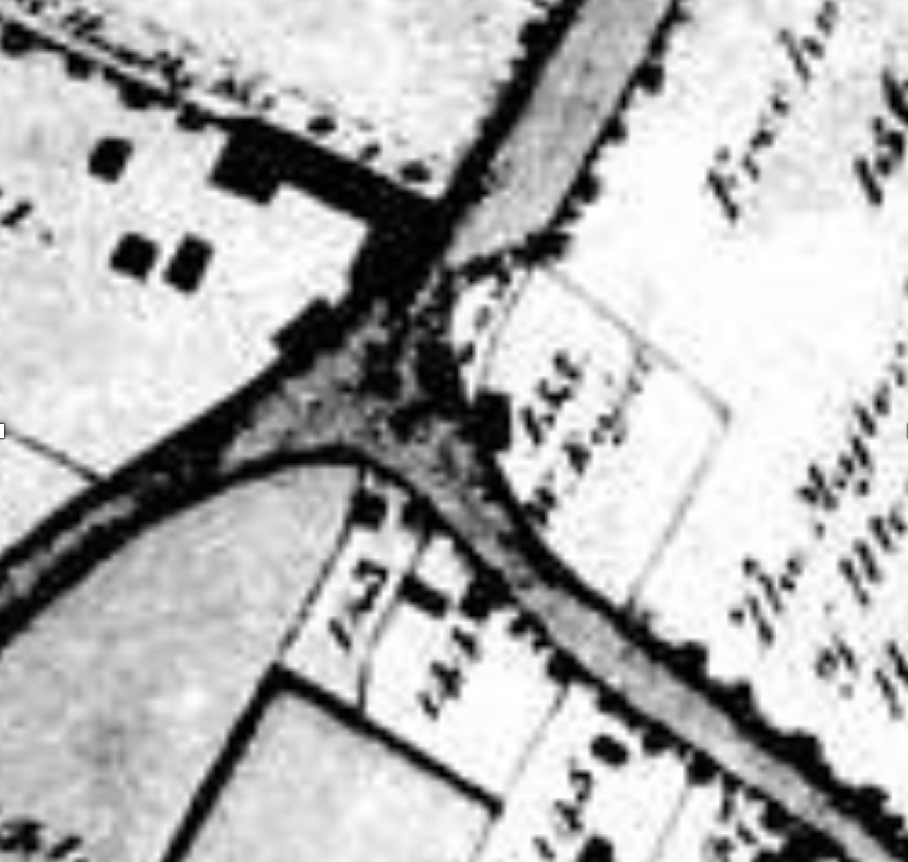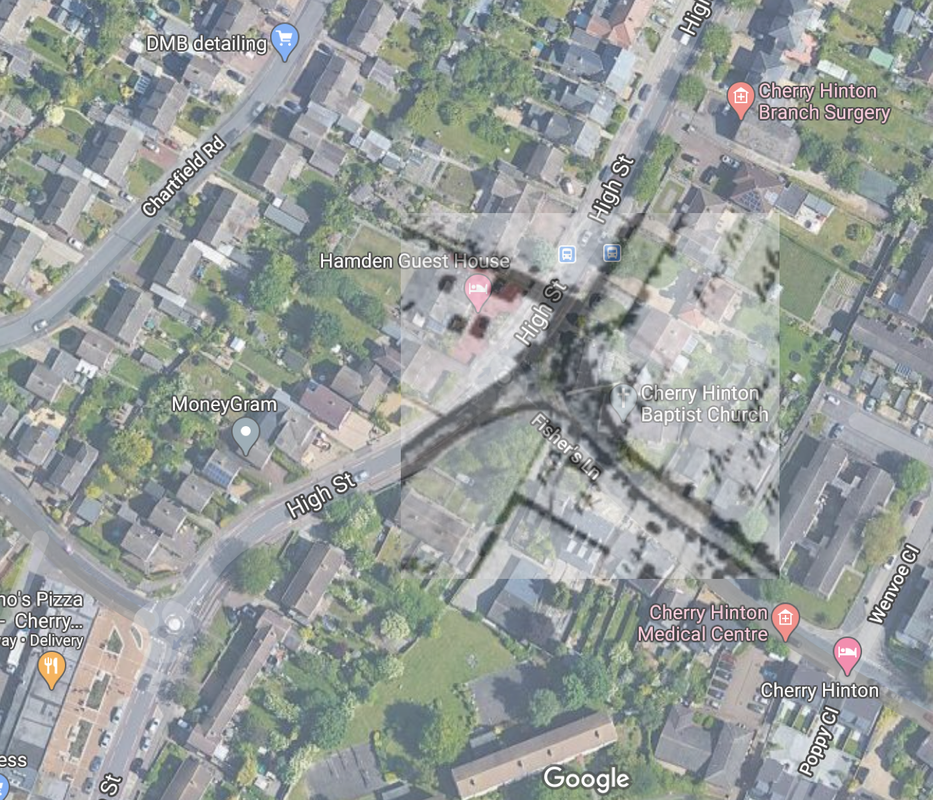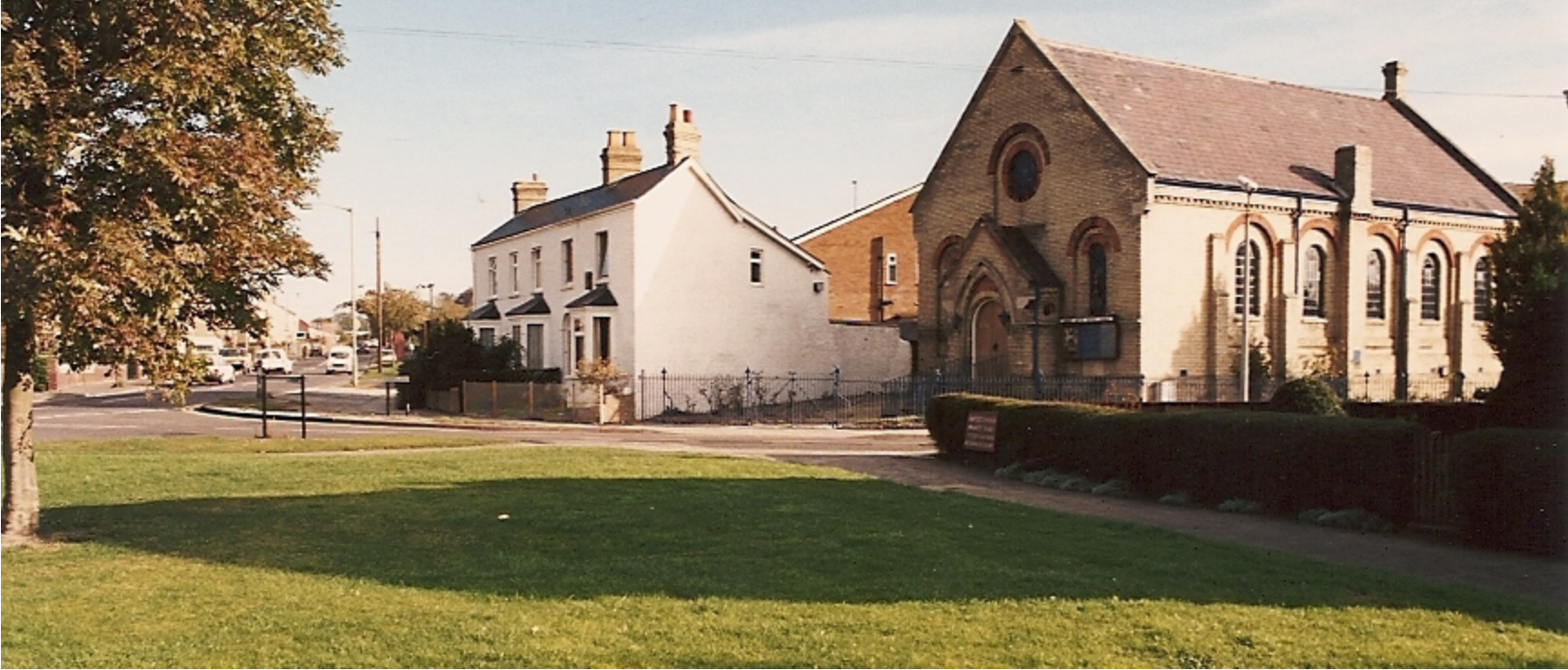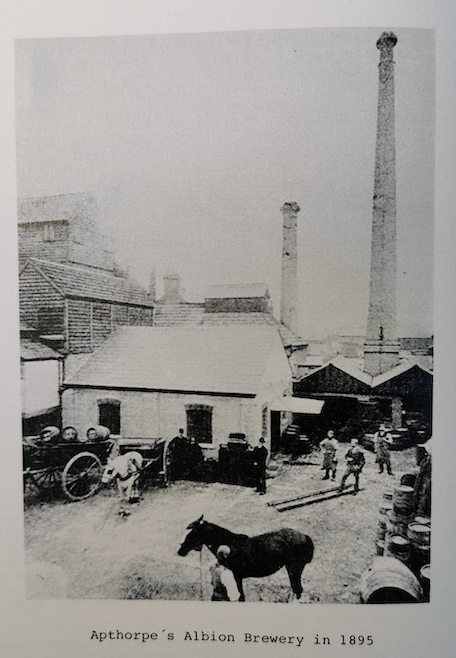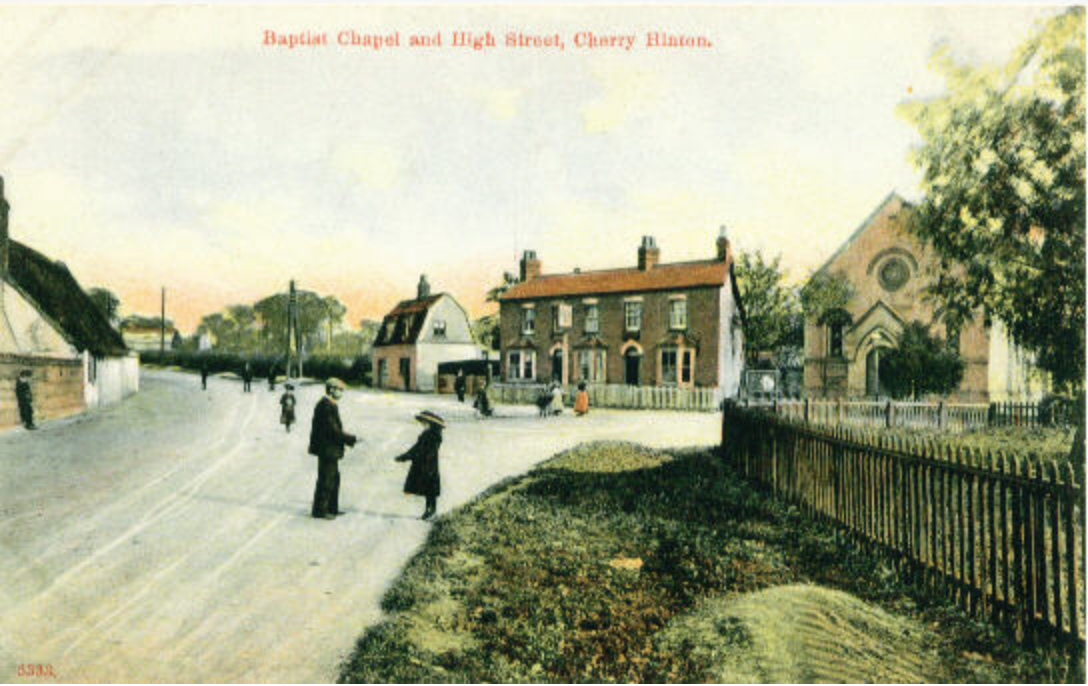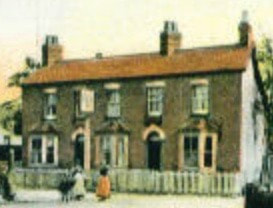|
Here you will find the complete contents of Cherry Hinton Memories Book One - if you haven't done so already, I would encourage you to take a brief look at the introduction page about these books first - which you can do by clicking the link here: Cherry Hinton Memory Books - Introduction
There are three books altogether and one separately written story - you can find the links to the other books and story by visiting the Cherry Hinton Memory Books Introduction page, mentioned above, or by searching the index (Categories) on the righthand side of this page or by using the search box on the right.
BOOK ONE
Book One “The Cherry Hinton Gang” Those Golden Years
Contains memories from: Mick Covill Bill Chapman Kay Smith Diana Lilley Ann Gentle Chris Kirch Gill Rapley Sue Gentle Ronnie Clark Tony Mason
Below you will find the full transcription of book one, copied as it is, with pictures of the handwritten stories to compare (and send me any corrections!). You can choose to read through it here or, for more detail, you can click on one of the names above to see their story individually and any extra pictures that I have added to illustrate their story.
Book 1 “The Cherry Hinton Gangs” Those Golden Years.
Mick Covill 4th Jan 2011
‘Yess’ .. I do hold Cherry-Hinton with a great love & fondest memories. I myself was not born in Cherry Hinton but was born and lived in Broad Street of East Road Cambridge, born in 14-Aug-39. Can only just remember the last part of the war air raid shelters and the Anderson shelter we had in the living room which we got under when the air raid sirens went off. My mum & dad moved to Cambridge when he got a job with Ralph Thompson as a painter. We then were offered a council house in either Trumpington or Cherry-Hinton but as the house in Fernlea Close were built by R. Thompson and the yard and offices were in Fernlea Close my mum & dad chose Cherry Hinton. We moved to Cherry Hinton when I was about 9 years old into number 6, the beginning of my life in Cherry Hinton. I always remember Bert Quinney’s shop just in the High Street. You used to go in like a dark cellar where they sold most things. They then had a house & shop front built at the front of Fernlea Close, where we used to do most of our shopping. Bert Quinney used to be the local Bookies runner, and my dad used to give me some money wrapped up tightly in paper & say take this up to Bert’s. Bert who used to call me Billy - don’t know why – used to slip the money under the counter. If dad won any money he would send me up to Bert’s & I would say “have you anything for dad”. Bert would say “I will have a look” and then produce another bit of paper wrapped around money and say “here you are Billy” and slyly pass it to me to take back home. Bert Quinney’s shop was always open from early morn to late at night, he was a good man, friendly and kind. One of my early introductions to Cherry Hinton was when Kenny Sutcliffe, who I did not really know, wanted to have a fight with me and my brother John. If I remember we declined and ran home. My sister Marie and I went to the Catholic School in Cambridge, so we knew Ron Clarke and his family, also the noble family and the boys Peter George and Paul who lived on the High Street. Their father George was the bone collector from all the butchers. I suppose my introduction to the friendship that Cherry Hinton was to offer me was passing my 11 plus exam and going to the Central Grammar School. Here I met and was in classes with John Anderson, who lived in the prefabs in Church End, and Ray Williams or chick to most people who lived in Queens Meadows. Also, Tony Short who lived also in Fernlea Close. I used to do a paper round which was run by Jim Chapman, Bill Chapman’s uncle, I did Pen Close, Shepherds Close, Fishers Lane and worst of all, Fulbourn Old Drift. The drift was not very nice as it was very dark and everybody had guard dogs, which were not that friendly. Jim Chapman ran the paper business from the back room in the Chequers Pub run by Tony Tabor’s mum and Jesse his dad. The years slowly passed and there are memories of all the new families moving into Cherry Hinton i.e. the Medow’s family, the O’Reiley’s - Paddy, Patric, Phillip, Brendon, Fergie – very poor families. I used to go scrumping walnuts with Paddy in Chalk’s farm off the High Street and finished up with stained hands which lasted weeks. There was Jimmy Davidson, Mick Williams, who I think went to the County School also moved in. When recalling names there was a great friends Peter Boland & Mick Boland, who lived down Mill End Road with sisters Margaret & Liz, also Stan Paine who lived in Rosemary Lane. While I drift from name to name let’s not forget the Youth Club which was held in the old Cherry Hinton Infant School by the Labour Party members an old record player playing the latest hit songs and then the skifle groups who and about, and then the Youth Club held at the Lower Netherhall School and also the dances held in the British Legion Hall, Fishers Lane, where all the latest budding groups played. At these events all us Cherry Hinton boys and girls danced the night away and if I remember correctly no alcohol. Flashes come back to me now of the Queen Edith’s school dances where the lads would sit in one corner of the room reading in Cambridge Blue, a paper with all local football results and pictures. Must not forget my friend J Poulter who I met at Central School and I introduced him to the Cherry Hinton way of life and am sure he then made many, many friends. Down the Red Lion pub, run by Norman and Joan, we played darts and bar billiards and on a Sunday morning we all played football which could last up to 2-3 hours and then we would go to the Red Lion for a drink. Norman would have loads of orange drinks lined up for us all which quenched our thirst. Must not forget Cherry Hinton great such as Brian Stevens, Peter Dean, John Bertram, Danny Buttress, Mick Scoett?, Matt Lindsay. I think ... could go on and on and write page after page. The pages I wrote may not have been of historic or exciting events but a small glimpse of some of the people I met from school to growing up and can say Cherry Hinton is in my blood. I love it, maybe I love the past more than the present because it has changed so much. However, I thank all those people and friends who made my life in Cherry Hinton such a wonderful life. Yours Mick Covill
Bill Chapman’s Story Written 26/04/2011
I was born in Fisher’s Lane and then moved to Fulbourn Road when I was two months old. I went to school with my sister Shirley. We used to walk along a path which was called Long Walker (which started at Fulbourn Road and ran along the back of Cherry Hinton Rec where Colville Estate is now. How the High Street has changed! There used to be a cottage on the corner, opposite the Robin Hood (just outside the Spinney). An old man, Mr Clark lived there. In the Spinney, gypsies would often park and live there sometimes. At the junction of the Robin Hood there were no traffic lights as today, but a little slip road from Queen Edith’s Way to Cherry Hinton Road and then the other road went straight across to Cherry Hinton. There was a little triangle green in between where Mr Snowy Scott used to preach on a Sunday evening. Mr Scott used to grow his own tobacco. On the left hand side there was a big hole (where a bungalow is now), we used to sledge there (it was called Prior’s Field). Sheep were herded by the Creek Brothers from the Chalk Farm (off the High Street) to fields at the back of Fulbourn Road (near the water softener where the water company is now.) Next to the water softener there was a big barn where all of the wheat sheaves were gathered and stacked and threshed with a threshing machine. There used to be loads of rats and mice around there. There also used to be hare hunts that came through the village with all the hounds and then chase the hares at the back of Fulbourn Road. Taffy Lloyd (from Queens Meadows) was the local poacher. He would put snares out in Lime Kiln Quarry and you would see him coming home on his bike with rabbits across the cross bar. Percy Tabor was the nightwatchman at the chalk pits (where the caravan site is now). Luffy Tabor used to drive the steamroller through the village, and he was a great friend of my dad. Rarzo Tabor was the landlord of the Robin Hood. Dad, Luffy, Rocky Root and Tubby Anderson used to sing around the piano at Christmas at 56 Fulbourn Road (where we lived). There were two bakers: one in Fulbourn Road called Don Smith’s – the other one was in the High Street – Root’s Bakers. Then there was George Parish the butcher. Across the road there were two cottages next to the shop. There was another butchers opposite the rec (where the Building Society is now). Next to the Rec was Sid Hancock’s (the cobbler) shoe shop. Then the Chequer’s Pub run by the Tabors. Across the road from the Rec was Steven’s Building Yard where we used to keep the football marking machine. My dad (Olly) used to mark the football pitch. My dad was well known in Cherryhinton because he helped run the football club. My mum and dad were good parents. Next to Love Lane (where the bank is now) there used to be a smallholding with chickens and ducks in a field. Next to that was Chalks Farm (roughly where Desmond Avenue is now). There was a big drive where they took cows across the High Street to the field opposite. There was a big pond in the field opposite (roughly where Colville Road is now). Further on opposite Fisher’s Lane there used to stand a big tank filled with water. On the corner of Fisher’s Lane, I used to go to Chapel with my sister Shirley. We would be dressed in our Sunday best. Next to the Chapel (towards the railway line) were a row of 4 cottages (only 2 now) and then a police house. This was occupied by Mr Laddington who was the village copper at the time. Mr Bartram was the crossing man who was in charge of opening the railway gates (he was the father of my friend John). Just over the railway was the green hut where we went to youth club and played table tennis. Neville Cullup was a very good table tennis player. The school next door in an old building which has now been pulled down. Tommy Bray was the headmaster and he lived in a house next door (next to the Green Hut). Just across the road was the Five Bells pub and Quinney’s store where I used to buy my sweets. B.C.
Memories of Cherry Hinton from Kay Smith
I lived in Mill End Close until I was 17 years old. I think we were all very lucky to have lived in such a small safe community. In Mill End Close most of our parents were married just before the war and as was usual most of our mother’s either didn’t work or had part time jobs – unlike today. My parents bought the house when they married in 1939 and my mother’s 1st cousin bought the other half of the semi so I was fortunate as an only child to have 4 cousins next door, namely Cynthia, Charlie, Diana and David Lilley. Diana being 3 weeks younger than me, Chris and Lorna Ketch, Ann and Sue Gentle, John and Christine Cornell and John and Peter Hedge, all similar in age lived in this great little cul-de-sac. We all went to the village school together, walking safely through the village without parents coming with us. We had Miss Wilson in reception class – with orange juice, cod liver oil and malt. Plus, the small bottles of milk, which in winter we stood beside the large ‘turtle’ heaters to defrost the ice. We had Miss Rush in the second class and I remember her saying as we left the class that we had to leave the bead frames behind but take our fingers with us. I think it was on Friday mornings in assembly that we heard a record played but I only remember the Flight of the Bumble Bee and Finigal’s Cave. Perhaps they only had 2 records. I also remember Jeffrey Rheimen singing Greensleeves – he must have been good or brave! We had some sad momentous occasions when Mr Bray died and also when we were in Miss Dunnetts class someone came into class and whispered in her ear and she announced, “The King is Dead”. There was a great celebration on the Rec for the coronation and everyone dressed up in fancy dress. I was a black cat. I also remember watching the hunt leaving from Chalk’s Farm – an amazing sight. We used to go to Ling’s sweet shop opposite the school, and buy packets of crisps from Smith’s shop with the salt in the blue paper and hot bread from Root’s – all in the High Street. Our favourite play areas were the Spinney, catching sticklebacks in the brook – and falling in. I went to church on Sunday mornings and then to the Baptist Chapel for Sunday School afternoons. The vicar was Fatten Forrest who drove an amazing car and used to bring carrots to school for us to eat in a wheelbarrow. He always seemed very shy but was very kind to me. When I went to see him about getting married in the church but no longer lived in the parish he suggested I use a different address – so my marriage certificate gives Ann Gentle’s address and the Gentle’s very kindly let me get ready and leave the from their house.
Cherry Hinton Childhood – Diana Lilley
As Kay has said, I also lived in Mill End Close, my parents bought the house in 1938 and my mother lived there until she died in 1995. They were truly very happy days, the whole of the Close very good friends – always helping one another out – I remember in the summer all the mums and dads loading up old prams with games and equipment and food, and we would walk over Lime Kiln Hill to the Beach Woods – We would spend the whole day there playing rounders, cricket etc. using the trees as our posts. The parents would light fires and perhaps cook sausages etc. on to eat. We used to have a great time, and then again walk home. We were always very safe having games in a very wide area, and never any fears hanging over us. Kay also mentioned memories of Junior School, many of which I can remember. One thing Kay did not mention that I remember, was when we heard our 11 plus results, we individually went into see Mr Farmer, as it was then, and told our results. From school we were taken to Coldham’s Common swimming pool in our final year to learn to swim whatever the temperature in an unheated pool. Thereafter I would spend many days there at the cost of One Penny for the whole of the day. Playing in Cherry Hinton and spending a lot of time in the Spinney. I remember walking to the Robin Hood corner and seeing the patients from Fulbourn Hospital out for a walk. They were all tied together and were resting on the wall outside the Robin Hood Public House, before walking back. I found this very frightening. I could have been no more than 10 when Kay and I decided we would cycle to Balsham, which was a fair way. On arriving at my great aunts who had a farm, and I loved to visit – apart from the outside loo – (a shed with a wooden seat – with a hole in it). She said “Does your mother know where you are”, well as we said “No, why, should she, we are quite safe” – to which she fed and watered us and sent us home. I went to Cherry Hinton Church with my brothers and sister on a Sunday and continued on to confirmation classes in the vicarage with Mrs Forest. The vicarage was a very large rambling house – we used to sit in one of the rooms for our class – and the ceiling was peeling off on to us. It always caused quite a laugh. Needless to say I did get confirmed in 1956 at St Pauls Church on Hills Road, and I did get married in Cherry Hinton Church in 1964. When we were old enough, I delivered papers for Mr Seal – both morning and evenings, before and after school daily and on a Saturday I worked for Mr Bird the greengrocer in the new shops in the High Street when Colville Road was developed. As mentioned previously in this book, I also had to deliver to Fulbourn Old Drift – a very dark and not a very nice place to be in the dark mornings and evenings, likewise, the caravan site on Bennett’s Farm, Mill End Road. I often had to get my dad to come with me. Coronation year 1952, Kay’s family were the first in the Close to have a television and I remember each family having a time slot in which to go around and watch the occasion. They also had a motorbike and side-car which I remember being taken in when I was 11 to fetch my first pet dog Mick, and I also married a Mick! There are many things in this book already that I recall – the cycling through either the Tins or the Snakey Path to the secondary school and later on to work. Quinney’s shop open 7 days a week – when mums ran out of something on a Sunday – he would sell it to us – and then wrap it in newspaper to disguise what we had. It was illegal to sell certain items on a Sunday years ago. We were extremely lucky to have had our childhood in Cherry Hinton – we were well cared for and looked after. Very happy days. Several of us have flown the nest, but we still keep in touch regularly, for lunch and a chat – Kay Smith, Chris Ketch – Ann Gentle, Gill Fordham and myself. We are friends for life.
Cherry Hinton Memories Ann Gentle
I lived in Mill End Close with my parents and sister Sue – who is 3 years younger than me. We were a close-knit community only 22 houses in the Close, and all the children played together. I went to the village school and was in the same classes as Vic Phillips, they were happy days. I remember us giving Mr Reed? our class teacher the bumps on his birthday, he took it all in good sport, I remember going to Mr Ling’s shop and buying 1p OXO’s to eat as we could not buy sweets because of rationing. I still like them now. The summer holidays were great, we had the run of the village, going tiddler snatching in the brook, climbing trees on a ree?, many’s the time my dad would have to come and get me down as I got stuck up a tree. The Spinney was another favourite, my mum didn’t like me going up there but it did not stop me. My dad kept racing pigeons and Tony Tabour and many of the boys used to come and see them. Vic my dad went to Crystal Palace with your mum and doing the High Jump I think they went to the same school. 1927 was the years I think they would have been about 14 years old. The High Street was a lot different to what it is now, there were 2 farm cottages at the top of Mill End Close they belonged to Chalks Farm. The Jonson's lived in one of them. The farm was where the hunt used to go from, and we used to go and watch. In autumn we would scrump walnuts I have always liked them. opposite the farm there was a field with a pond. In the winter it would freeze over and we would skate on it. One day on the way to school I decided to have a go, the ice wasn't very thick and I fell in afraid to go home and tell my mum I sat in school all day in wet clothes. When I got home, someone had told mum she made me have a mustard bath to stop me catching cold. We used to go to parties in the Chequers pub they were great fun. I left Cherry Hinton in 1963 when I married J Holmes. We lived in Chesterton for many years and had two sons I now live in Landbeach. My son Kevin now lives in my home in Cherry Hinton having bought it when my mother died so the connexion still goes on as I come back home quite often. Ann Holmes
Some of my memories of Cherry Hinton – Chris Ketch
Our Cherry Hinton is unrecognisable from the one of today. There was only one pavement along part of the High Street, small gas street lamps and Chalk’s Farm on both sides. I remember a bull being in the field in summer and skating on the pond in winter. Twice a year the sheep were herded through the High Street, no traffic calming then, thank goodness. I too was a Mill End Close girl, living there for 20 years with my parents and younger sister Lorna. The Millers, Janet, Roger and Sally, lived 2 doors away, Jackie and Danny Buttreas? across the road and Les, Win and their son Richard “Bonzo” King next door. As the girls have said before, it was a safe, happy environment in which to grow up in. Everyone’s parents respected each other, the mothers calling each other Mrs, not using forenames and all extremely hard working. School was a good experience then. Mrs Runnett getting us to chant times tables in the tin hut, Mrs North playing her piano accordion and being flung around by the boys who hated dancing. We often played marbles after school, rolling them down the High Street on the way home. In the winter we made long slides on the ice and formed an orderly queue for a “go”. It was also where I met Gill Fordham, my very good friend who came to live on the “new estate”. She is an adopted Mill End Close girl now. The wonderful Bernard Reed was the best teacher ever. How he remembers us all I will never know. Sports days were a great occasion. The MC used to be Mr Thompson, Susan and Caroline’s father. Margaret Boland was a terrific runner, I did beat her once but only once. I remember Billy Taylor rolling one of the Richardson boys along in a huge tyre in one of the races. Gill and I came third in the three legged race on our last sports day. We won a comb each and we got a big cheer when we collected our prize and it felt like an Olympic medal. Summer holidays were long and the best ever. Groups of us would disappear all day in the Spinney, on the Rec or the Beech Woods. Sometimes we would club together to buy a hot loaf from Roots the bakers to eat on the Rec. If it was wet we would play Monopoly in Di Lilly’s dad’s shed, for hours on end. Church, Sunday School and Bible class was the plan for Sundays. We took a few pence for the collection but Lorna decided to pay a visit to Ling’s sweet shop sometimes and spent her collection money on sweets. Our mum found out when bubble gum stuck around her mouth. After Sunday morning service we would pick up an ice cream block from Quinney’s shop which he wrapped in newspaper. This was kept on the pantry floor as we had no fridges then. As teenagers we went to youth club in the school hall and the British Legion Hall in Fishers Lane where some good local bands played live. No alcohol or drugs then but we had a really great time without the need for either. Today, I live in Fulbourn where I see several old school friends. John Richardson works very hard in his woodyard at the bottom of my garden. Horace White is landlord of the Six Bells and lives near me. I also see Tony Mason around the village and Herbie and Marie Williams. All of them are still so friendly. Great memories of very happy days spent in Cherry Hinton. - Chris x
A New Life in Cherry Hinton – Gill Rapley nee’ Fordham
I came to Cherry Hinton with my parents Bill and Chris and my sister Margaret in 1952. We moved into one of the new council houses in Leete Road on the Colville Road estate. As newcomers we were not welcomed by all the villagers, some obviously thought this influx of strangers would change the life of this small community and not for the better! I well remember the terror of standing in the playground on my first day at the primary school next to the level crossing and knowing absolutely no-one. That school with its coal fires, outside toilets and overflow class in the Green Hut was, it turned out, a wonderful place of learning with headmaster Mr Farmer, teachers Bernard Read and Miss’s Rush and Dunnett who enabled many of us to pass the 11+ and move on confidently to High School and Grammar Schools. School holidays were spent in the Spinney, on the Rec, blackberrying on the Roman Road and exploring the Beechwoods. There were huge steam rollers in Pamplins Yard and Mr Fabbs equally huge pigs to feed in Fulbourn Old Drift. The Norman Cement Works along the Tins path was always fascinating with the huge cauldron of liquid cement constantly being fed by the chalk lorries from the pits in Lime Kiln Road. The Green Hut with Brownies, Guides, Cubs, Scout groups, youth club and table tennis club was our social centre. I learned to Jive there to Paul Anka, Everly Bros and Elvis and I also fell in love for the first time, all such bitter sweet memories. There were more pubs than shops when we first arrived but eventually Mr Seals newsagents, Mr Bowyers grocery shop and Mr Birds greengrocers augmented Bert Quinney’s and Lings sweet shop. The friends I made all those years ago thankfully remain my friends today – I see Chris, Kay, Di and Anne quite regularly and so many of “the boys” now spend their retirement on the allotments on the Black Land where Mary and I spend a great deal of our time. Cherry Hinton was a good place to move to in 1952 and it is still a good place to live in 2011 and I am thankful for it. – Gill
Sue Gentle March 2012 Mill End Close
My sister Ann (Gentle) brought this notebook of reminiscences to show me. Reading them made me want to contribute so here goes! I have lived in the Pennine Hills almost twice as long as I lived in Cherry Hinton but my memories of my happy childhood are vivid. As others have mentioned we were so lucky to have had the freedom to roam, climb trees, make dens, go on long cycle rides. We would run home at lunch time then rush out to play again. Or sometimes we would take picnics which meant we were away from home for hours. This did not cause any parental concern as it would have me with my children. As already mentioned by Kay, Mill End Close was a new build just before the war and most of the houses were bought by young newly married couples. Because of this a lot of children were born there, including us. As a consequence, we were never short of playmates. One of my first memories was of the close being flooded and having fun paddling in the road with our shoes on. The year before I started school Peter Hedge (who was one year older than me) broke his arm so was off school. He and I went up the Rec to play on the swings (yes, with a broken arm!) Whilst there a hunt passed by heading for what was then the fields beyond. We were so frightened by the noise the dogs made – we swang as high as we could to escape them. Now when I hear a lot of dogs barking I think of this. I remember walking to school with Christine Cornell and her pet chicken Billy. When we reached the level crossing we told Billy to go home, and it duly did. One day I took my little doll to school – she was my pride and joy. On leaving school some boys in my sisters year (was it you?!) took the doll off me and when it was returned it had one leg missing. I cried all the way home. The leg went missing by the level crossing. Because I was so upset my dad went to look for it in the dark with Mr Bartrum the crossing keeper. He had a paraffin lamp. The leg wasn’t found but the next morning my doll had a wooden leg carved by my dear dad. It was even more special to me after that. We loved to climb trees at the top of the Rec. How pleased I was with myself when I managed to get from tree one to tree seven without touching the ground. My sister got stuck up one of these trees and had to stay there until our dad came home to rescue her. I thought her a bit of a sissy! We learnt to do things on our own like riding a bike and swimming. The former by getting on by a bench seat on the Rec and by falling off when wanting to stop. The latter by spending much time at Coldhams Lane swimming baths which I remember as always being cold. It didn’t bother us though. I loved school especially Mr Read’s class. His classroom was of a wooden construction that was separate from the rest of the school, it was near the railway line. One day, when I should have been paying attention, I counted the number of freight coaches there were passing by. I hadn’t realised Mr Read had stopped talking and was looking at me. When he asked me how many coaches there were (I still remember there were 23) I had to write out 23 times “the goods train engine was pulling 23 coaches”! We had a great time in Mr Read’s class doing project work. One project I was involved in was a study of the flora and fauna in the Brook. This was an excuse to have fun! He would allow us to go to the Brook in project time and we would come back invariably late and wet having paddled too deep or fallen in. Imagine a teacher giving pupils that freedom now! How fortunate we were. Our parents had modest lifestyles but they gave us a very rich and secure upbringing in Cherry Hinton – Sue (Gentle) March 2012
Ronnie Clark 12-6-09
I remember in the 1950’s when Cherry Hinton had the best village football team in Cambridgeshire, and around the 1950’s when Cherry Hinton was a village, sadly no more. Farms up the High Street, Smiths bakers in Fulbourn Road. A piano playing all the old songs on a Saturday night in the Robin Hood. I remember the sheep being brought from Fulbourn Road down the High Street to Chalks Farm. Old Ken Baker riding side-saddle on the big Shire horse, chewing a bit of straw, delivering muck for the allotments behind Fulbourn Road. Those were the days. Walking to school from Fulbourn Road down what was classed as Long Walker (a path which ran from Fulbourn Road to Fishers Lane) before the council estate was built. And the other footpath which ran from between Fulbourn Road and the old Dutch barn over the hill to the Beech Woods. No longer there (but could be if the locals had it opened up). I remember Mr Ollie Chapman, 56 Fulbourn Road. He used to cut my hair for sixpence on a Sunday morning. If I did not keep still he would clip my ear. Oh those memeories. Catching rats and rabbits when they done the harvest, the foreman from Chalks Farm, Mr Dawson, could not catch us. I remember Bill Chapman, who I owe so much for what he did for me, and was one of those players along with Peter Dean, Brian Stevens who would be todays £50,000,000 football players who played with pride. I could go on and on. Always dreaming but the times have gone, two other men I must mention are Douglas Kitson, who was like a brother to me, sadly no longer with us, and Bill Taylor from the High Street who also I owe so much to. I was born in Fulbourn Road, no. 34. Nickname Nobby. Cherry Hinton, thanks for the memories.
Tony Mason's Tale (born.1-12-41) June 2012
Lived at 10 Railway Street next door but one to Nev Cullup in a road where everyone knew everyone with a real community spirit. Kelly Ling a good friend of my sister Ann lived about halfway along the long row as did Marglin? Bird, Rodney Smith, Andrew Tabour and Richard Hallam? We had wonderful bonfire nights in those days with everyone mucking in building the bonfire and pooling our fireworks and potatoes for roasting later. Nev who still works in the village as a cobbler in his mid 70’s needs a medal for he was struck with TB as a child which severely disabled him but he was brilliant with his model aero engines and later so good at table tennis. My memories of Cherry Hinton are really happy ones as it was such a wonderful rural village in the 1940’s and 1950’s and just a fraction of its present size. There were no houses between Fishers Lane and Jane Elwoods old thatched hut still stands next to the library, there was just a lovely meadow with cattle and horses grazing amongst daisies and buttercups but in the winter it flooded in its lower part to form a small lake on which we would float an old tin bath using a slab of wood as a paddle and when frozen it was brilliant for slides. In summer if the cattle were not using the field, it was used for a rounders or cricket pitch by the chapel the quality of the pitch being questionable, but we did have David Shepherd (yes the England cricketer) play on it. He and Bob Jones used to help out at the chapel whilst they were at Cambridge University and on Sundays they would stay with Joyce and Stuart Hill in Fishers Lane (Sue and Jane Hill’s parents), poor Jane had a hole in her heart and went through much surgery as a child at Guys Hospital in London, I think it was the early days of heart surgery. There were just a few houses in Fishers Lane with a field on the left hand side where they held the village feast after the war and just beyond this field Prefabs were built to help house families of troops returning. At the bottom of Fishers Lane, which was quite short, were large fields stretching across towards Fulbourn Hospital where as a young one it was marvellous to watch the old binder making sheaves of corn which were stacked to dry before being pitchforked onto carts some horse drawn and some by an early tractor pulling them back to Chalks Farm which had a beautiful avenue of walnut trees roughly where the chemist and bookies are in the high street. It had a grand old farm house, surrounded by fields to the front going up the hill as far as the railway and very large barns built of chalk blocks and timber. Mr Chalk was the auctioneer, Grain? and Chalk, later to become Cheffins. He also had land to the south of Fulbourn Road where he grew corn and in winter moved his sheep well up the hill in compounds of bales, when they first came out, where the shepherd had his living van, dog with horse and cart so he could keep a close eye on the lambing as it progressed. Behind Chalks Farm was a winding part of Mill End Road where the road followed the shape of the brook which ran open in those days, not in pipes as now. There were fields and stables where the wealthy of the University had their beautiful big horses kept which later became a riding school. Further down Mill End Road was Arnolds Farm which again had tennis courts to the side of a large farmhouse with lots of corn haystacks in the farmyard. A steam engine would arrive in autumn/winter to power the thresher which sorted grain from the straw. This farm had an ex-prisoner of war Hans working on it, he was a friendly chap who used to let us ride on the trailers up to fields to the north of Fulbourn Old Drift and to those near the cement works north of the railway. It was great fun and mum would get one to take a bag with me to glean the loose ears of corn for the chickens and straw for my rabbits. Mr Fabb (Doreen’s father) had quite a lot of pigs in a large shed in a small field on Fulbourn Old Drift where I used to go with him at feed time and when he was ploughing it was great to hitch a ride on his old Fordson tractor which ran on paraffin. Next door to us in Railway Street lived Ray Coustons grandparents. Rays father used to come in a large van and sometimes we would go to the colleges to collect the vegetable cast offs which after he had sorted out the better veg at his Fishers Lane yard he would take the rest for his pigs that he kept in Church End somewhere near where Listers old building used to be. Dr Stracham lived in the big house in Church End used to give us school children a real treat in the autumn term by bringing a whole barrow load of apples into the playground. Another real treat in those days was the strawberry teas they used to do on sports days. We would all sit at great long tables with white tablecloths in the playground like a street party. Back in the High Street was Lings shop just above the railway line on the corner of Railway Street. I always remember queuing in a really long queue on a Tuesday evening when they first had ice cream delivered. Between Lings and the old 5 Bells was nurse Armanents? thatched cottage, she was the District Nurse. Between the 5 bells and the old Quinney’s shop (the one you went down steps into) at the rear was a sizable house with Battlements and vast gardens and tennis court which was where Pamplins the steam engine contractors used to live. It was a large business for its day with engines out all over East Anglia. Nev Cullup’s grandfather Jim Fisher was Foreman and many of the workers were housed along the row in Railway Street. Luffey Tabour from Cherry Hinton started as a teaboy/cook for a steam engine gang and later drove engines for most of his life. He told me he would often be in the Lowestoft area for 6 moths at a time. The last steam engine I remember commercially working in Cherry Hinton was when I was quite young in the field north-east diagonally across from the church. When Wimpeys built on it dad always said it should never have been allowed because the land was left to the church for a further graveyard. No wonder there’s no room in the churchyard to bury people now. As a child I used to play in Orchard Estate with Martin Capon?, Teddy Harding, Ronnie Heywood, Dickie Pilsworth, Horace White, Peter Crabb. We used to go fishing in the brook in summer but I always remember Horace leading us through the village to meet a bus at the Robin Hood on which was coming the greatest den builder from Fulbourn (Rocky Root) who needless to say, after waiting for several hours, never turned up. But when he eventually moved to Cherry Hinton to live proved to be a great guy who still tends his allotment by the brook even though he now lives in Landbeach and has proved to be the best roof carpenter I have ever known. Many lovely people moved into Cherry Hinton with the new houses being built all around and the village seemed to have the greatest football team of all time, Brian Stevens left wing (Swavesey always put 2 men on him but he still ran through the pair of them), Peter Dean, Mick Cornish, Bill Chapman, Ron Hagaty, Sam Bartrum, Brian Merry, Bill Taylor, Jimmy Nunn, Winkey Wells, Tom Watson, Pete Bland and many more good players. They seemed to win everything. Brian played for Cambridge United then Leicester City he was outstanding the Beckham of his day to us young ones. In my early days a tramp would knock our door and ask for his dirty old paint tin to be filled with tea, another similar sort of chap but cleaner would come on a bike with a stand that raised his wheel so he could pedal and drive a grinstone on which he would sharpen scissors, knives and shears. In Fulbourn Old Drift there was a small railway siding where a few railway trucks filled with coal would be backed onto for the local coal merchant to unlock by hand into sacks on his cart. Mr Doughty, who had a wooden leg, lived near the siding and worked for the railway trimming the wicks of oil lamps and filling them with paraffin for the railway signals. Doreen Tabour (nee Rowlings) who still lives in the row in Railway Street was relief railway gate lady. Mr Bartrum, John’s dad, was the resident gateman who lived in the old station house. The hunt in the old days which was quite a spectacle, normally left from Chalks Farm but on some occasions left from the Vicarage, the hounds I think came from Gingell? of Horningsea, they looked magnificent. Steven Bros Builders yard used to be next to Mr Bendalls old thatch which after a fire became the site of a garage but is now housing. The blacksmith shop, run by Kitch Gentle, opposite the Red Lion pub was the place to take glass accumulators to be charged for powering our radio as we did not have electricity, our lights were by gas or oil lamp. Upstairs at the back of the blacksmith shop was a beautiful picture with Springfield Farm on the edge of Cherry Hinton Road. There used to be another farm “Ventress” on the other side of Cherry Hinton Road just slightly along near the start of Cherry Hinton Hall, which again was burnt down for Harold Ridgeon (Sindals) to build more houses. At the top of Fishers Lane just on the High Street was Clintons big drying shed where washing was deposited for the village ladies to wash and iron for the University. Several houses in those days had washrooms in their back gardens just behind their house. It would contain a water filled copper heated by a fire below. Another large shed was at the back of the Steggles house in the High Street next to Joan and Bill Taylors house where tobacco would be dried. On the opposite side of the High Street was the Co-op Shop where later Freddy Reaverone? Was manager they had cables across the ceiling which took the money to the cashier, quite fascinating to watch as a child but the system seemed to hold up everyone because they had to wait for the cashier to process it and send it back the change in a little pot in a carriage zooming across the room against the ceiling – Hi Tek for its day I guess but slowed everyone down. In later days the Rec was enlarged to include where allotments used to be behind the Chequers Pub. There seemed to be a lovely croud of lads came to live in the village, Herbie Williams from Stotfold moved into Leete Road, John Anderson into the prefabs in Church End, he was a brilliant lad, he built such a good hi-fi system, I think he cast concrete into the base of a speaker cabinet he fabricated, the sound was so good that the whole prefab vibrated with the deep base notes. He was always up to something clever. I well remember the time when he made some metal tubes with a tiny hole for the fuse but with thread at the tube end which he would fill with chemicals from I think Jim Davidson which he would ask one to put a bolt at the end and gently tighten. It was nothing to see a massive branch blown off near trunk of a large tree with a horrendous bang as a test that it would work. Followed by PC Plod roaming the neighbourhood for the next few hours when we had to make ourselves scarce. But John’s father was very good at fobbing him off because PC Plod knew very well who had probably done it. I shall never forget the tremendous boom in the toilets (when they used to be underground) in the centre of Market Square) one Bonfire night, I’m sure it must have been heard halfway to Newmarket. I went with Herbie, Stan, John Poulter and others to learn to ride a motorbike at what was the old cattle market at the top of Cherry Hinton Road on Sunday mornings, it was a brilliant system where Hallens and Kings Harpes provided a bike for each of us to learn on off the road around the cattle market lane system. Needless to say we all got bikes which gave us the freedom to roam anywhere from there on. It was a wonderful time you could always tell when Stan was zooming through the village on his fanny barnet, it seemed the throttle only had one position. I remember Vics younger brother Gordon riding pillion on the back of mine whilst Vic was on the back of Stans, Gordon never realised he was going to fly as we took the railway gates going downhill at full throttle – happy days, we were the lucky generation, we had all the benefits of prewar tranquillity with orange juice, cod liver oil, chocolate and later milk at school each morning and in our teens, when most older lads would have to do 2 years in their National Service, which most thought was a waste of 2 years in their prime of life, even that was stopped just a year or two ahead of us. I think the last from the village who had to go were Sammy Bercham, who went into the RAF as did Paddy Reilly, what a smashing lad he was to come into the village with bros. Pat, Fergie and others in the family. Pete Noland I think was the last to go into the army, unless someone knows different. My dad Charlie was a bricklayer who worked until he was 74, quite a heavy job till that age, he would cycle all over as far as Girton but if he was working around town or nearer he would always cycle home at lunch times as well, people were really fit in those days with no cars to get about with. One of my fondest memories is of walking my son David, when he was little, to the cement works to watch the rotating machinery mulching the slurry to meet dad on his way home, David would sit on dads coat on his bikes handlebars with his feet in his basket, I think both of them were in heaven walking back through the Tins pathway. It was such simple things that gave such pleasure in those days, I can’t think of anywhere beter to have been brought up unless we were all living by the coast, maybe Bembridge I.O.W. (Isle of Wight) where Stan, Mick Colville and a group of us went for a holiday one year, before we had 4 chalets in a row at Skegness with a group of 16 of us another year with some of Vics United pals who joined the village lads at the Red Lion. We were a lucky generation. Tony Mason July 2012.
If you'd like to support the work that I do and the archive, why not buy me a virtual coffee, I'd be really grateful and it will help keep me going!
Just click on the green button below :)
2 Comments
The Russian Arms Public House
The Russian Arms was a public house in Cherry Hinton, Cambridge, that was positioned on the east side of Cherry Hinton High Street, one house north from the Baptist Chapel, on the junction of Cherry Hinton High Street and Fisher's Lane. The records that I have found, so far, for this pub cover dates from 1867 to 1912. So, we know that it was in existence for at least 40 years as the ‘Russian Arms’.
The present-day map below shows the approximate position of the, now private, house which used to be known as the Russian Arms – marked with the red dot.
Here is a picture, below, of the building as it stands today. It is the building on the left, with the burgundy front door in the center. The top three windows from the left belong to this building, along with the 2 bay windows either side of the front door.
The only physical clue that we have to show us that there was once a pub on this site is the name above the front door, shown below, which states “Russian House 1867”
This clue gives us a solid date for this building and for, perhaps, its deliberate construction for use as a public house in 1867. There are no records of a public house upon this site, named the Russian Arms or otherwise before this date. Although, as we can see from this portion of the Cherry Hinton Enclosure Map of 1806, there were certainly buildings of some kind on this plot.
Here is the same map roughly overlaid onto a modern map - see if you can make out where the roads and buildings relate.
It is very likely, due to the angles at which both the older buildings depicted on the 1806 map and the later Russian House building stands, that they were positioned to face what was once one of the village greens in Cherry Hinton. Traditionally, the often thatched, cottages would line the edges of a village green to face inwards in order to be able to keep an eye of the cattle and livestock overnight when they were brought back in from the common land - just a little further down Fisher's Lane was a small common called Drayton Common (now built upon) which was in use throughout the medieval period. There is still some evidence today of the green at the corner of Fisher's Lane where it joins with the High Street. There was also a large pond (now filled in and built upon) on the other side of the road, on the High Street directly opposite the Baptist Chapel - giving clues to one of the features often associated with a village and it's green - a village pond. Perfect for keeping the livestock watered. It was very common to find a pub within this scene but as I have mentioned we have no records suggesting a pub on this site any earlier that our 1867 Russian House/Arms.
The records that I have found, that mention or relate to the Russian Arms, are as follows (in chronological order):
OCTOBER 29th 1881 – Cambridge Chronicle
“ “Russian Arms” Public House, and 18 tenements mostly brick and slate, ANNUAL RENTAL £133 14s. TO BE SOLD BY AUCTION BY WM. WALLIS, ON TUESDAY, November the 8th 1881, at the “Russian Arms”, Cherry Hinton, Cambs, at six for seven o’clock in the evening, by order of the Mortgagee with the power of sale in the following or other such lots as may be determined upon at the time of sale……. LOT 4. All that New-built Brick and Slate PUBLIC-HOUSE, DOUBLE FRONTAGE, known by the sign of “The Russian Arms”, with a frontage of 66ft. 6in. The house is admirably adapted for business, having the above frontage with large Bay Windows and containing 8 Rooms with Club Room, good Cellar, Range and Copper, also a side gate Entrance to stable, Cart Shed, with lost over, Brick and Pantile outbuilding, etc. There is a Drying Ground to the back of this property with a width of 8ft. and a depth of 50ft. The above is let to Mr. W. H. Apthorpe on a lease expiring the 25th. March 1883 at a yearly rental of £35. Copyhold of the Manor of Hinton Netherhall.”
This is the first documentary evidence that I have found that discusses our pub. You can see from the record that it is regarding the sale of the property. We know from that date of the building, that it appears to have been constructed in 1867. 14 years later in 1881 it is being sold along with some other properties and the auction of all of these properties, along with the pub, is taking place at the Russian Arms itself. Auctions of property often took place in public houses in those days. What we can see from the description of the Russian Arms, is what it would have looked like and how that correlates to what remains today. The description lists the Russian Arms as 'new built', which in essence it was, being about only 14 years old. The large bay windows mentioned are still there today and we get a good description of what the building and pub itself would have been like, inside and out.
The seller of the property is William Wallis, an agent for the Netherhall Manor estate, and the property is copyhold of the Manor of Hinton Netherhall. There were once four manors in Cherry Hinton, two situated in Church End (the north part of Cherry Hinton) - Uphall Manor and Mallets Manor and two more situated in Mill End (the southern part of Cherry Hinton) - Rectory Manor and Netherhall Manor. Netherhall Manor was one of the largest Manors and would have been a physical manor house with a large administrative role in the village. Today there are no manor houses in physical form left -each one having fallen in to disrepair, gone out of use or pulled down. The only one that we do have some evidence of still standing, is that of Uphall Manor, which stands in Church End as a private house now. It was extensively remodelled and changed, the only clues to its original purpose hidden behind later brick encasement. (A separate blog is being done for the manors of Cherry Hinton, where you'll be able to read more there). At the time of this sale of the Russian Arms in 1881, Netherhall Manor was no longer a 'manor house' but was an administrative body which ran the estate and lands still belonging to what was Netherhall Manor.
The other key piece of information within the sale details is that the Russian Arms was being let to Mr W. H. Apthorpe, his lease was due to expire in another two years.
Both William Henry Apthorpe junior and his father W H Apthorpe were both well known brewers and public house owners in Cambridge during the mid-late 1800's. In 1868 William Henry Apthorpe junior had acquired the Albion Brewery in Coronation Street in Cambridge. His father owned the Victoria Brewery in Napier Street. W H Apthorpe senior retired from brewing by 1875 and the pubs that his brewery controlled were passed on to his son. By 1895 the Albion Brewery had at least 50 tied pubs in Cambridge - presumably including our own Russian Arms.
It is wholly likely then, that beer brewed at Apthorpe's Albion Brewery, shown in the picture above, was sold and served in the Russian Arms, here in Cherry Hinton.
An article on Albion Brewery on capturingcambridge.org shows what happened to the brewery after this date:
1896: acquired hy Lacon 1913: E Lacon & Co, brewers, wine and spirit merchants H W Badcock, Granta View, Stapleford, manager 1962: E Lacon Ltd, brewers wine and spirit merchants 1965: Lacon taken over by Whitbreads. Site demolished soon after.
The last date of use of our Russian Arms, being a working pub in the village, is 1912. So from the information given above it would have seen at least one change of ownership and probably brewery - that of the change in 1896 to Lacon.
In the London Gazette 1862 we find further evidence as to which Apthrope - father or son - would have been involved with our Russian Arms:
"NOTICE is hereby given, that the Partnership sub- sisting between us the undersigned, William Henry Apthorpe and William Henry Apthorpe the younger, in the business of Maltsters and Brewers, carried on by us at the borough of Cambridge, under the firm of Apthorpe and Son, was this day dissolved by mutual consent. All debts due to and from the partnership will be received and paid by the said William Henry Aptborpe, by whom the busi- ness will in future solely be carried on.—Dated this 12th day of May, 1862. W. H. Apthorpe.' W. H.Apthorpe,junr." With our building being constructed in 1867, it would mean that the Russian Arms would be in the management of William Henry Apthorpe junior.
Shortly after the notice of sale, in November 1881 we find the following announcement:
NOVEMBER 12th 1881 – Cambridge Chronicle “On Tuesday last, the following property, situate at Cherry Hinton, was sold at the “Russian Arms”, by Mr. Wm. Wallis:-……………… LOT 4. The “Russian Arms” public-house, with cart-shed, loft and brick and pantile outbuilding, copyhold of the Manor of Hinton Netherhall, fine certain, sold to Mr. W. H. Apthorpe for £480.” This shows that Apthorpe junior goes ahead and buys the Russian Arms and becomes owner rather than the tenant of the property. It does make me wonder though...If the Apthorpe's were the first to run a pub there and if they didn't actually build the building itself (as tenants only, why would they have?) then perhaps the naming of the pub "The Russian Arms" was simply due to the house being called "Russian House" as we can see remains the name above the door today. This means rather than searching for reasons for naming a pub the Russian Arms, the line of enquiry falls to why the original building was named Russian House. I would, at this point, be inclined to think that the Russian Arms was so named after the house itself....although....having said that...surely it was built for use as a pub rather than converted - if we go by the sale description of the building? this is a little mystery to solve!
We can see that the pub was still in business in 1887 as it is mentioned indirectly when an announcement is made in the Cambridge Newspaper regarding two cottages that were being sold next door - notice that Fisher's Lane is referred to as "Chapel Lane" due to the Baptist Chapel which was built in 1870. This name doesn't seem to be used very often in the records and today retains the preferred "Fisher's Lane". There wasn't another small lane next to the Chapel which could have had this name that can be discovered as of yet.
March 4th 1887 – Cambridge Chronicle “CHERRY HINTON, CAMBS Two Freehold Cottages in Chapel Lane…..and Two Brick, Stud and Tiled Cottages, situate next “The Russian Arms” Public House, …..”
In 1888 we find an entry that shows the Russian Arms still going strong and playing its role as an integral part of the community, when an inquest is held at the pub - again, along with auctions, sales and various club meetings, village pubs were often used to hold inquests and court session.
JANUARY 20th 1888 – Cambridge Chronicle “INQUEST – Mr. C. W. Palmer, the county coroner, on Wednesday, held an inquiry at the “Russian Arms”, Cherry Hinton, into the circumstances attending the death of Blackman Flack, aged 57. The deceased had been an outpatient at the Hospital, and died rather suddenly on the 11th inst. A post-mortem examination, made by Dr. Perkins, showed that death was occasioned by consumption, and a verdict to that effect was returned.”
In 1893 we again find reference to the Russian Arms through an announcement regarding the sale of some cottages next door.
MAY 26th 1893 – Cambridge Chronicle “Two Cottages, Brick, Stud and Tile built. Situate next the Russian Arms Public House….To be sold.”
Then the final newspaper entry that I can find for our pub, dated 1894, is in regard to another inquest held at the premises:
SEPTEMBER 7th 1894 – Cambridge Chronicle “A FATAL FIT An inquest was held at the “Russian Arms”, Cherry Hinton, on Wednesday evening, by Mr. A.J. Lyon, County Coroner, on the body of Susan Merry aged 49, who died somewhat suddenly on the previous Tuesday morning. David Merry, a labourer, the husband of the deceased, said on Monday afternoon, while his wife was washing, she fell down in a fit. She was subject to fainting fits, but on this occasion she did not rally as usual, and she never spoke again. He did not send for a doctor, as he thought she would come round; he had known her to be in a fit for six hours. There was no change in her condition from the time when she was seized until just before she died.- Mrs Sarah Watts said when she was called to the deceased she was lying insensible on the floor of the kitchen. She remained in that condition for two or three hours. The doctor was sent for when witness though the deceased was dying.- Dr. Nicholls, of Fulbourn, said he had made a post mortem examination of the body, and was of the opinion that death was due to heart disease. It was doubtful if a doctor could have done any good had he been sent for at the time of the seizure. The jury returned a verdict of “Death from natural causes.”
It is worth now checking the census returns to see who was actually living in the building over the years and to see if we can find a solid date when the building stopped being a public house.
The first entry that we have for the Russian Arms is in the 1871 Census - about 4 years after being built. Census returns were done every 10 years, the previous return was for 1861 - before our building was erected. I did however search the entire Census entries from 1841 - when they started - through to 1861 just in case there was any evidence of a pub previously on the same site but there was none.
The following details are given in 1871 Census: Russian Arms, High Street, Cherry Hinton, Cambridge Thomas Merry, born in Cherry Hinton, aged 33, Head, Beer House Keeper - living with him are; Charlotte Merry, born Little Wilbraham, aged 32, shop keeper - along with Fred Merry, 1 year old and George Merry 1 month old, both born in Cherry Hinton. Notice that Thomas is running the 'beer house' but that his wife Charlotte is noted as a shop keeper - was this her occupation elsewhere in the village or town of Cambridge or did she run a small shop from the pub premises? A couple of doors up from Thomas and Charlotte are further members of the 'Merry' family - perhaps Thomas' parents. They are predominantly Agricultural labourers.
In the 1881 Census the following details are given:
Russian Arms, High Street, Cherry Hinton, Cambridge Thomas Merry, born Cherry Hinton, aged 44, porter - living with him are; Charlotte Merry, born Little Wilbraham, aged 44 - along with Mary A Merry, aged 13, scholar, George Merry, aged 11, scholar, Frederick Merry, aged 10, scholar, Sarah Merry, aged 7, scholar and Rosina Merry, aged 2. No mention of Charlotte being a shopkeeper and Thomas is listed as a porter - beer porter? or an additional occupation? Their daughter Mary A Merry wasn't listed on the previous census, so was presumably staying with relatives when the last census was being taken. Frederick and George are still there and in the intervening ten years Sarah and Rosina Merry have been born.
In the County Directory, Thomas Merry is listed as a Beer Retailer and shop keeper in 1869 & 1879 and Beer Retailer in Cherry Hinton in 1883.
The 1891 Census tells us the following:
Russian Arms, High Street, Cherry Hinton, Cambridge- Sarah Fuller, aged 58, born Essex, Little Bury, Widow, Publican with her are her daughter Mary Ann Fuller, born Cherry Hinton, aged 36, Laundress and her son Charles Henry Fuller, born Cherry Hinton, aged 34, Carrier. As you can see from the above, the Merry family are no longer at the premises. Sarah Fuller was married to Charles Fuller and they had previous lived in Mill End, Cherry Hinton. Charles senior had been a railway labourer. After he had died Sarah takes on the business of running the Russian Arms. Sarah Fuller is listed in the County Directory as a Beer Retailer, Cherry Hinton in 1892.
1901 Census is more vague with its addresses and there is a possibility for the occupants of the Russian Arms, listed on the High Street, Cherry Hinton but it doesn't distinguish where exactly on the High Street or if it could be the Hopbine, Five Bells or the Russian Arms - all of which were on the High Street at this time. Annoyingly it does note the names of The Robin Hood, The Unicorn and The Red Lion - at least it rules those ones out. Even with reading through the addresses in succession it is still not completely clear - we do have an 'Inn Keeper' on the High Street called Jane Nightingale who is a widow from Barnwell, Cambridge and is living on which ever premises it is with six of his children aged from 11 -27 (all of whom were born in Trumpington - two of the girls are working as laundry workers - a well known Cherry Hinton profession). At the moment we can't say for certain if this is the family who are then living at our pub.
An interesting article in Ale -Cambridge & District Branch Newsletter Issue 391 February 2019 - discusses the interesting character of Joe Nightingale from Trumpington who's second wife was Jane Nightingale. They had been running the Volunteer pub in Trumpington. When Jane was widowed she came to Cherry Hinton and was running the Russian Arms in 1901. So it would seem it was the Nightgales at the Russian Arms at this date. "....his evidently very sturdy widow probably carried on in the Volunteer for a short time, but by 1901 she (along with much of her brood) had moved on to the Russian Arms in Cherry Hinton...." You can read more about this here: https://www.cambridge-camra.org.uk/wp-content/uploads/pdf/Ale391.pdf
The image above shows us what the Russian Arms would have looked like during its working existence, this is very roughly dated to around 1910. I will place a zoomed in version below so that we can see the pub and its sign a little better.
We have more luck with the 1911 Census, which gives the following information:
Russian Arms, High Street, Cherry Hinton, Cambridge; George Burch, Head, aged 38, born Ipswich, Publican. Annie Burch, wife, aged 36, born Eastmeon, Hants, married for 15 years, 7 children - all survived, assisting in the business. Florence Burch, born Eastbourn, Sussex, aged 14, domestic day girl. Winnifred Burch, born Eastbourne, Sussex, aged 13, school. Daisy Burch, born Eastbourne, Sussex, aged 11, school. Fred Burch, born Portsmouth, aged 10, school. Edgar Burch, born Cambridge, aged 9, school. Dorothy Burch, born Cambridge, aged 6, school. Edward Burch, born Cherry Hinton, aged 2. We can see that the pub is still running in 1911, the Burch family in residence. Given the age of Edward Burch, their youngest at 2 years old and being the first of the children born in Cherry Hinton, suggests that the family are relatively new to the village and therefore perhaps not that long in the pub itself.
We cannot yet access the 1921 Census until January 2022 when it is to be released. So now I shall turn to the County and Village Directories to see if we can find out anything else.
So far, I have been hitting a dead end for anything after 1911 to say that the pub was still in use and no records coming up for the Burch family placing them still there, so as it stands we know that the pub was still going in 1911 but that is currently the end date we have for its use.
The Lost Pubs (www.closedpubs.co.uk) project gives us the following information:
"The Russian Arms was situated on Cherry Hinton High Street. This pub closed in 1912 under the 1904 Compensation Act." Mike Petty (www.mikepetty.org.uk) also mentions this, in his compilation on Cherry Hinton, taken from historical newspaper reports: 1912 07 26 Licensing: Cherry Hinton Russian Arms, 12 07 26 1912 11 15 Licensing compensation for Cherry Hinton Russian Arms 1935 07 05 The Five Bells was one of five fully-licensed houses in Cherry Hinton. In 1920 the Hop Bine, next door, was done away with and the Russian Arms had been closed in 1912. Lacons the brewers said the extra penny on beer had hit sales. The Five Bells had been ringing harmoniously for a good many years to the comfort and convenience of the inhabitants and should be allowed to continue to ring a litter longer. The licence was renewed - 35 07 05b From these reports we can see that the Russian Arms ceased trading in 1912 and became a private dwelling house. The Russian Arms had closed as a result of the 1904 Licensing Act. It seems that the idea was to reduce the numbers of licences in congested areas, and compensation was paid under the Act. Under the Licensing Act, 1904, in the seven years from 1905 to 1911, 7,318 licensed premises were closed with compensation. Of these, 6,880 were in England and 438 in Wales. http://hansard.millbanksystems.com/acts/licensing-act-1904
Please do get in touch if you would like to make a comment or have any further information. More history and information on the other pubs in Cherry Hinton coming soon....
If you'd like to support the work that I do, why not buy me a virtual coffee, I'd be really grateful and it will help keep me going :)
|
Cherry Hinton History Pages:
Contents If you'd like to go straight to a specific article or blog post within the Cherry Hinton History Page you can click on any of the post titles in the list below and it will take you directly there. Alternatively, you can use the search box above to search by keyword or you can use the index further below. About & how to use:This is the blog page for my articles, memories and archives relating to the archaeology and local history of Cherry Hinton, a village to the southeast of Cambridge UK. The area covered is the old Parish of Cherry Hinton which today includes the Ward of Queen Edith's. The Categories below are really the keyword index of what is on the Cherry Hinton History Pages. Each is a clickable link which will take you to an article or blog which contains that word or subject.
Categories
All
Archives
May 2024
|
